Fire up the barbecue for these smokin' hot BBQ seasoning insights
Fire up the barbie because summer is just around the corner. Everyone has their own secret stuff whether it be a sauce or dry rub. Currently the global spice and seasonings market is worth $3.76 billion and the global savory applications will register a compound annual growth rate of over 4.5% by 2025. This increase can be contributed due to growing disposable income and rapid product innovations that are increasing the industry size.
Recently, the team at Caddle sent out a survey to our users asking them what their purchasing habits are like when it comes to barbeque seasoning. After gathering the results from 10,322 respondents, we’ve generated some insights that align with the industry and potentially promote new ideas.
What’s cookin’?
I’ll tell you that I made it from a few spices I had laying around the kitchen, but really, it’s the name brand stuff (shh!). But that’s because it tastes so darn good! Our respondents seem to agree, as 49% of consumers said that they purchase their barbecue seasoning based off taste.
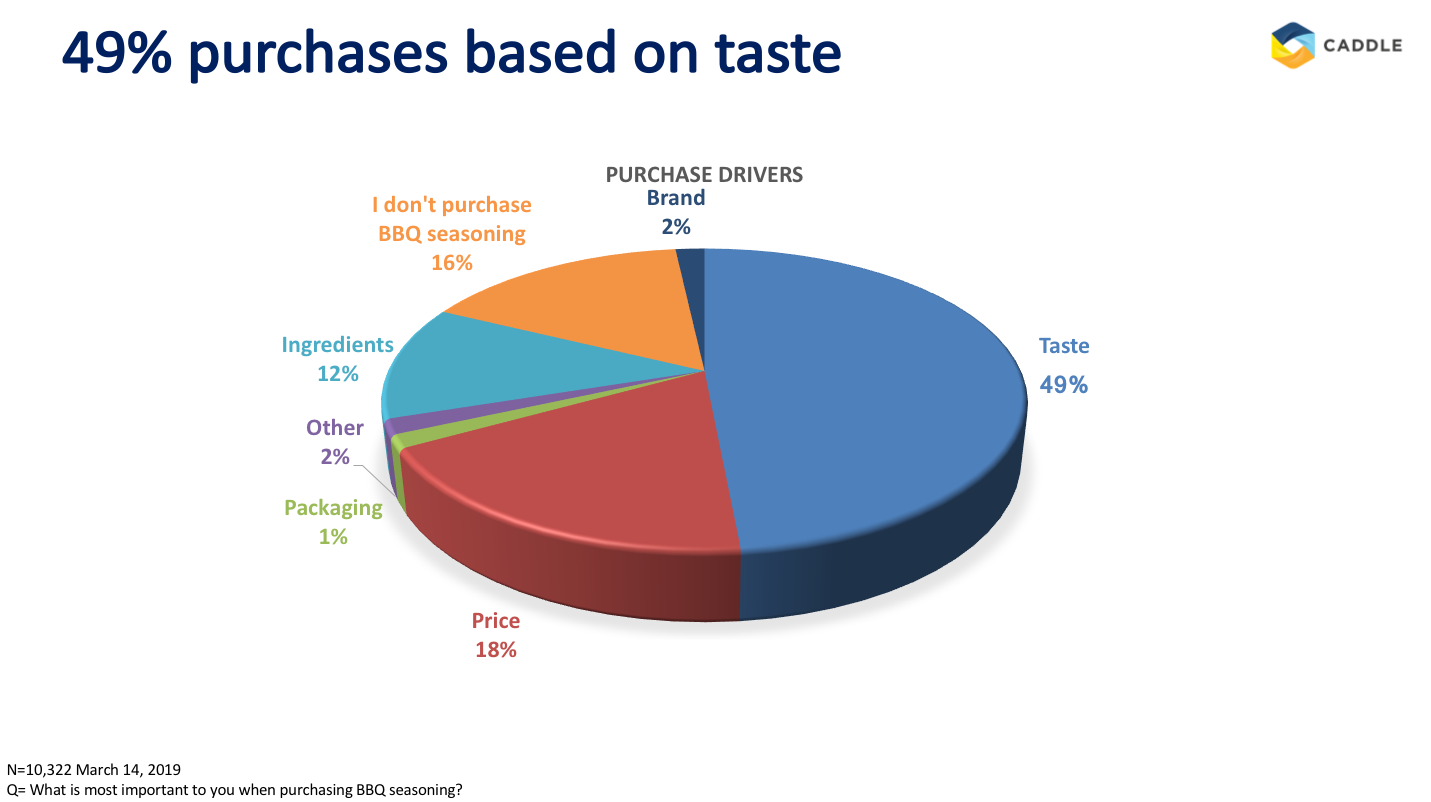
Studies have shown that we Canadians love our traditional sweet and sour sauces or anything with a bit of heat. But that doesn’t mean that the basics can’t be improved upon. The seasonings market works hard to manufacture and formulate several products that enhance the flavour, essence and taste that we know and love.
For those who are a little more daring, the industry thanks you! McCormick flavour solutions discovered that 12% of Canadians said that they like exotic or topical ingredients in their sauce. Not only does this contribute to our findings that consumers purchase their seasoning based off price, but this also allows for some interesting concoctions to be produced.
Spice up your life
Looking to travel the world from the comfort of your own home? Look no further because we have the solution for you. With the rise of ethnic food consumption being scattered throughout different lands, this foresees the opportunity for the seasonings market to increase. Having cultural rubs and sauces such as Jamaican, herbs de Provence, Japanese or African blends could become a real trend setter.
On the innovative side of barbecue seasonings 27% of respondents said that they are interested in themed flavour multi-packs when given a list of possible innovations. With a whole new cultural line added to their products this could allow for a competitive advantage for industry leaders. On the flip side, this could also allow new entrants who specialize in ethnically diverse spices to enter the market and generate a profit.
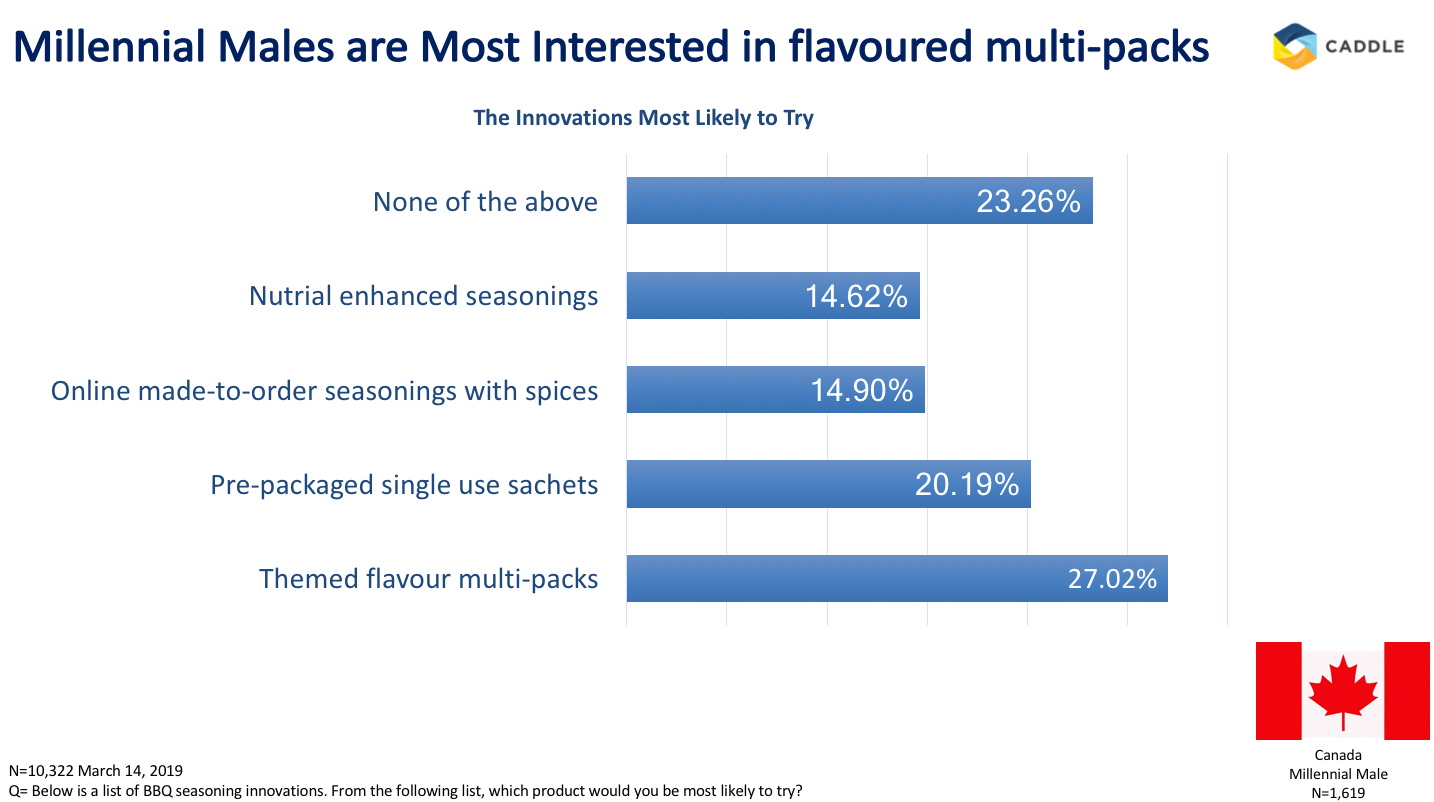
Fresh innovation
There’s nothing like making a delicious barbecue meal that is packed full of flavour. You can almost taste every spice that was used in the process of making it, but when you make it again the next month it just wasn’t as flavourful as the first time. Freshness is key. Consumers are more likely to feel that sauces are fresher when they don’t contain preservatives but rather contain spices and herbs in them instead. Perhaps another way to maintain freshness would be pre-packaged single use sachets. This is another innovation that 25% of our respondents said that they would be interested in trying. Instead of buying large containers of barbecue seasoning that doesn’t contain its freshness over time, single use sachets would be an innovation that not only allows for optimum freshness, but also allows for the diversity of trying different flavours.

So what?
There’s something about barbecue that has a spot in all our hearts. It acts as a great way to infuse all the seasonings into whatever we’re cooking. Whether it be the traditional sweet and sour, or Jamaican jerk spices, the seasonings industry is a large market that is proven to see growth over the coming years. With trends showing that consumers are interested in trying ethnically diverse seasonings while also maintaining optimum freshness, our survey results help provide insights into how industry leaders and new entrants can satisfy the wants of consumers via themed flavour packs and pre-packaged single use sachets.
If you’re in the CPG industry and are interested in gaining insights on your consumers, we encourage you to reach out to us and see how we can transform your questions into insights.
[simple-author-box]
Sunscreen: UV protection is important, but what is it?
Aside from being great summer activities, what do picnics, swimming, hiking and camping all have in common? Sunburns. Yes, as much as we all love the summer time for the endless opportunities it gives us to come out of our winter hibernation, there are some risks that come along with spending too much time unprotected from the sun.
The global sun care market is a profitable one that was valued at $14.8 billion in 2015. This market is expected to see a 5.8% compound annual growth rate which is expected to value the market at $24.9 billion by 2024.
With North America accounting for 35% of the global sun care market in 2015, Caddle sent out a survey to our users asking them their purchasing habits when it came to purchasing sunscreen. When comparing our insights to market trends we believe they could shed some rays on how those in the industry could maintain profitable gains.
Burning to be in your shopping cart
If your preferred brand of sunscreen was out of stock, what would you do? According to our survey results, 64% of you don’t seem to be too concerned as those respondents indicated that they would simply purchase a different brand of sunscreen. To industry leaders this hurts more than a sunburn. Leading vendors such as Estee Lauder, L’Oreal, Johnson and Johnson, Beiersdorf AG and Unilever are focused on maintaining their brand image.
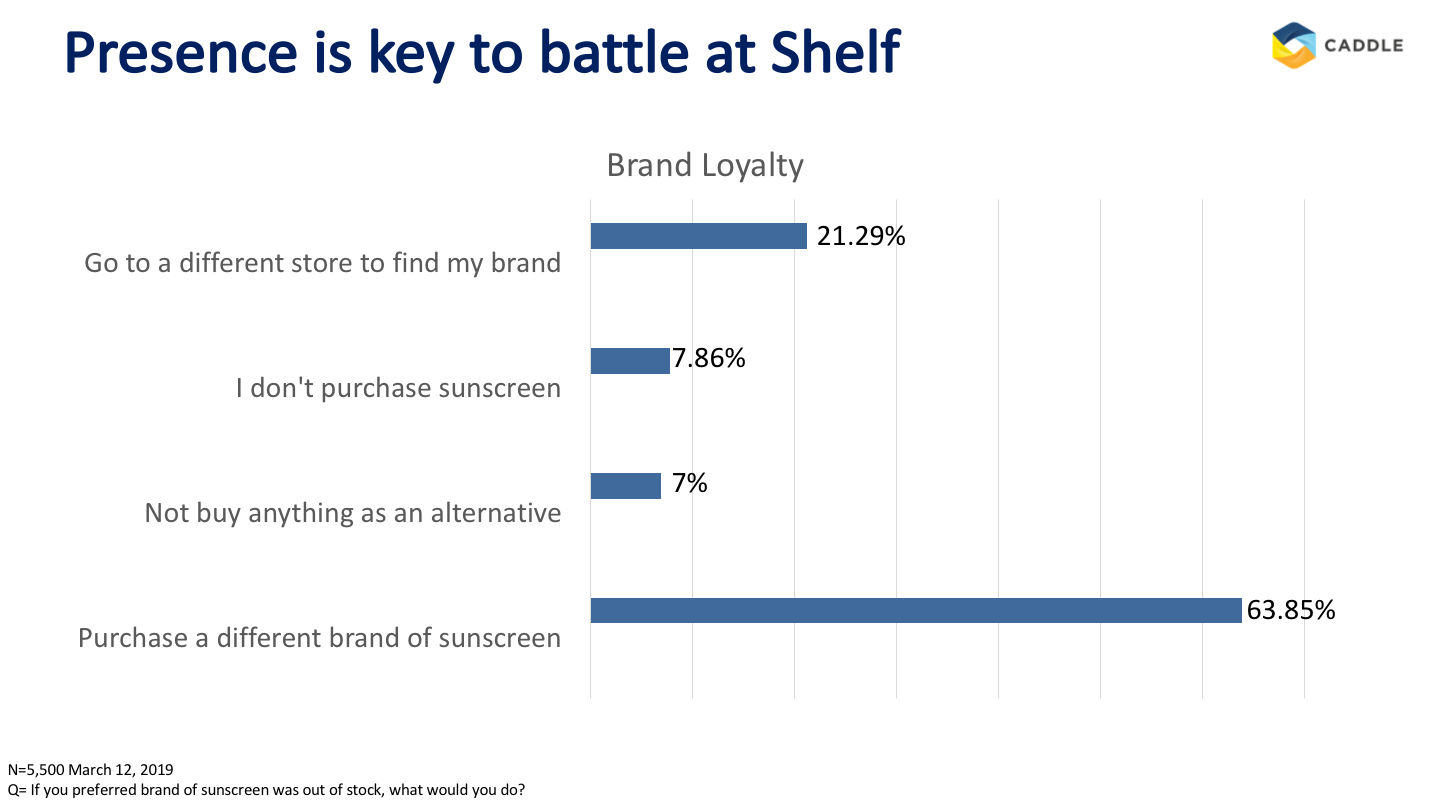
While another study found that one-third of sunscreen users are brand loyal, they also found that 62% of users aren’t picky and will use “whatever they have”, further justifying that consumers aren’t completely brand loyal when it comes to purchasing sunscreen.
While loyalty is hiding in the shade, leaders are focusing on including innovative products to their portfolio.
Au naturel
The whole purpose of sunscreen is to prevent the sun’s rays from burning your skin and causing more detrimental effects such as skin cancer. But consumers have also expressed the concern of using products that contain unsafe ingredients and can also cause severe conditions after prolonged exposure. The transition from unnatural products in cleaners and shaving creams have shifted towards organic and natural products. Similarly, sunscreen is the next runner up. The booming organic personal care markets have been additionally added to the general development of the sunscreen market. This is a step in the right direction as 43% of millennial females are most interested in organic or natural innovative sunscreens.
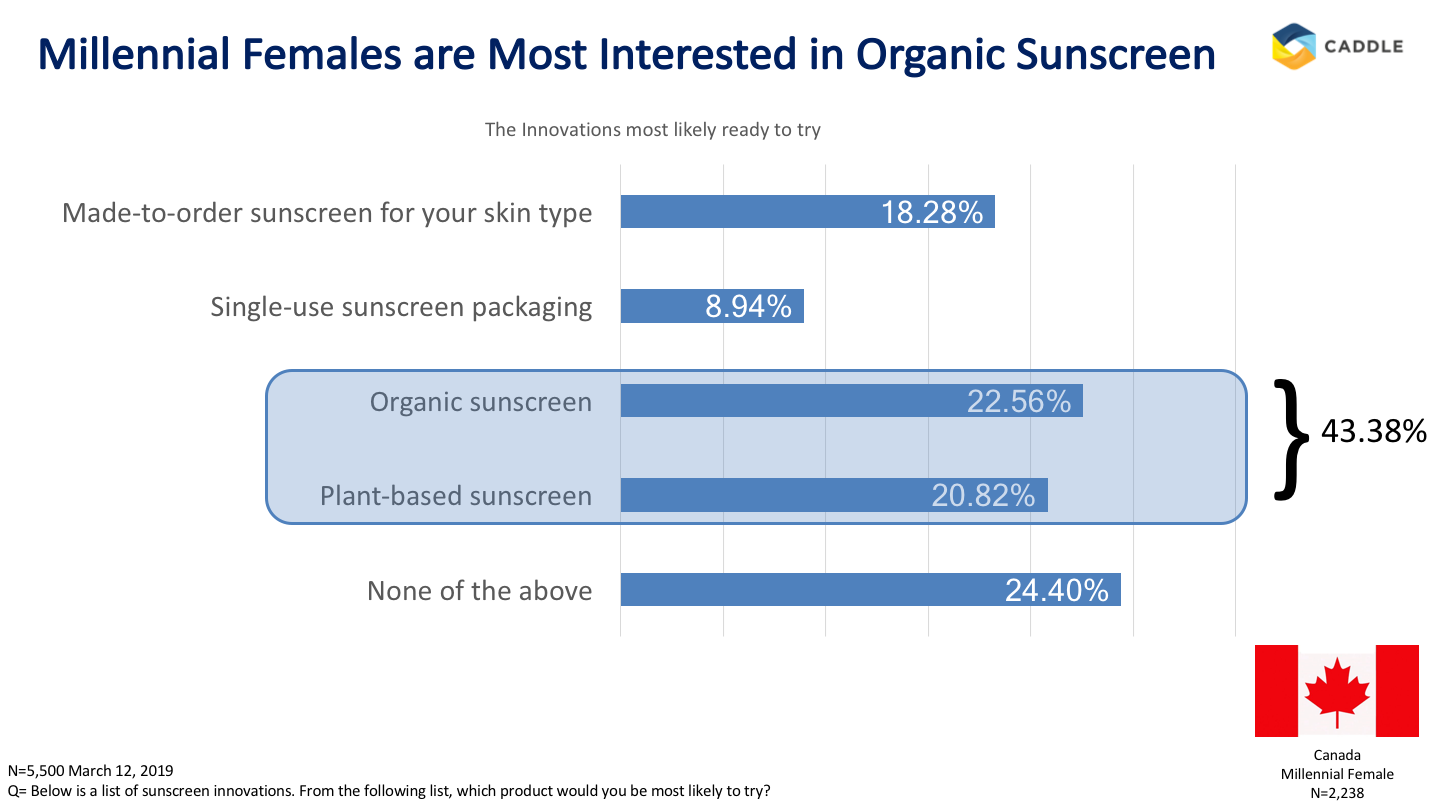
UV Protection
While brand might not necessarily be the purchase driver for sunscreen, UV protection certainly is. When asking our respondents what’s most important when purchasing sunscreen, 51% of respondents said that they purchase sunscreen based off UV protection. Time magazine quoted that UV protection/SPF number was the No.1 reason why consumers bought one brand of sunscreen over the other. Interestingly, only 43% of consumers know what SPF means. While simple, perhaps developing a product that informs consumers of the SPF numbers and what the numbers mean is an innovation that industry leaders could adopt to their products.
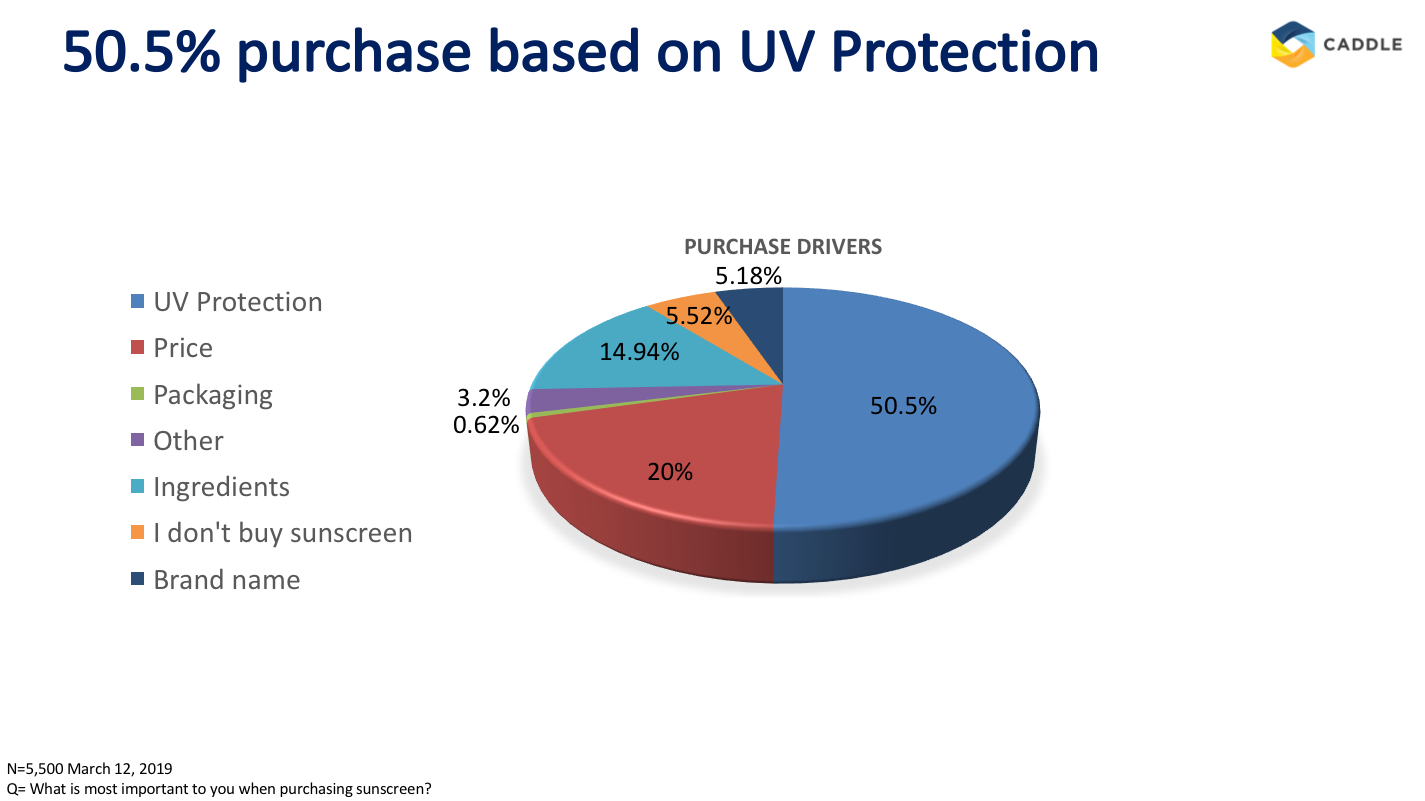
So what?
The sunscreen industry certainly is a hot topic which is showing rapid growth over the coming years. If you’re in the industry, don’t get burned from not following industry trends. Our insights align with the industry to show that consumers are most interested in chemical free sunscreens that provide effective UV protection. Furthermore, while leaders are focused on adding new innovations to their product lines, it may be beneficial to incorporate the meaning of SPF numbers as consumers aren’t entirely sure of its meaning and how it can be a benefit to them.
If you’re in the CGP industry and are interested in gaining insights on your consumers, we encourage you to reach out to us and see how we can transform your questions into insights.
[simple-author-box]
Get instant relief with these allergy medication insights
Spring has sprung, the grass has riz, I wonder where the allergy medication is. Yes, while the snow and gloom of winter has finally been done away with, the new season we welcome brings on rejuvenation of life and air borne pollen.
If you’re living in parts of North America and suffer from allergies then you know that allergy season is no joke. Due to the high pollen levels in North America, allergy medication has the highest demand in this region. As such, this high demand has created a very lucrative industry for stakeholders in the global allergy treatment market. With a market that brought in $9,706.0 US million in 2017 and an expected compound annual growth rate of 5.5% from 2017-2025, Canada and the US have become a market with high interest in new advanced allergy medication.
With so much opportunity floating in the air, the team at Caddle has just been itching at the opportunity to get our hands on some insights and compare industry trends to how our user base reacts to their allergy medication purchasing habits. After conducting a survey, we were able to obtain 6,308 responses that gave us instant relief on what our users want out of their allergy medication.
Sunny with a high chance of pollen
Are you an industry leader and you just can’t shake the headache of trying to figure out what your consumers want out of their allergy medication? Fear no more because 57% of our respondents indicated that they are open to new allergy medication innovations. Seeing as advanced methods of allergy medication are in high demand, this leaves you as an innovator in the perfect opportunity to experiment with what consumers might want to try.
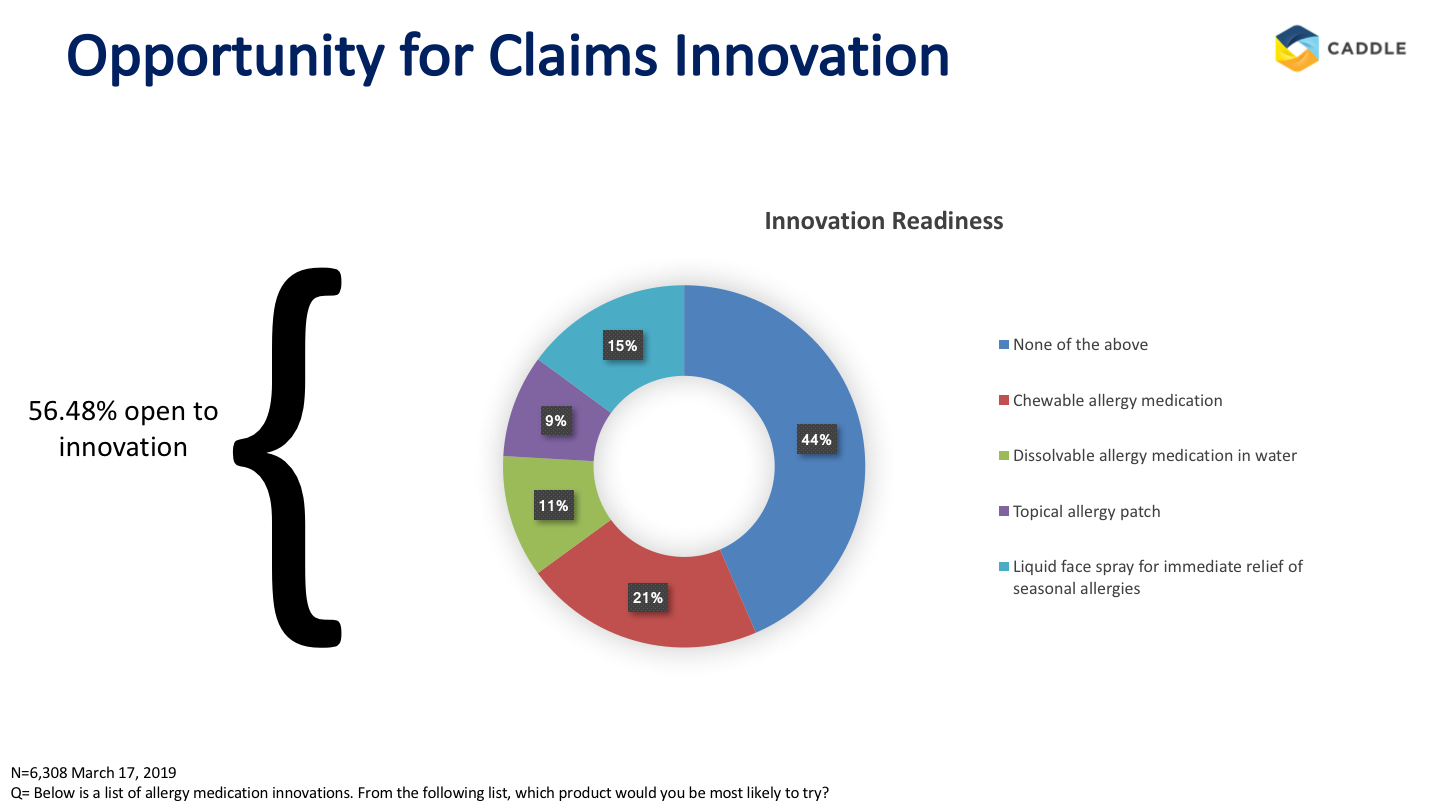
You check the weather, don’t you? So, what’s better than an app that tells you what the allergens are like in your surrounding area? This is something that Johnson & Johnson has begun to implement with their AllergyCast® app.
“We looked at when consumers were buying and taking their allergy medications and found that, for some reason, they were taking them when the pollen count was low and that seemed a little off,” said Sean Belke, Associate Brand Manager for Zytrec®. “Consumers didn’t really have the information they needed to understand what the allergy situation would be for them on a given day in their region.”
By uploading their area code into the app, the app will give you a scale of how bad the allergens are in the air and will thus help you predict how much medication you should be taking throughout the day.
Instant Relief
Do you ever find yourself in an awkward situation where your allergies hit you at the worst time possible so you pop a “fast acting” pill only to find out it’s not really all the fast acting? Well truth be told, you might not be taking your allergy medication fast enough!
Zeroing in on our survey results, while most of Canada is most interested in a chewable medication, we found that BC females are most interested in a fast acting face spray. But why the difference BC?
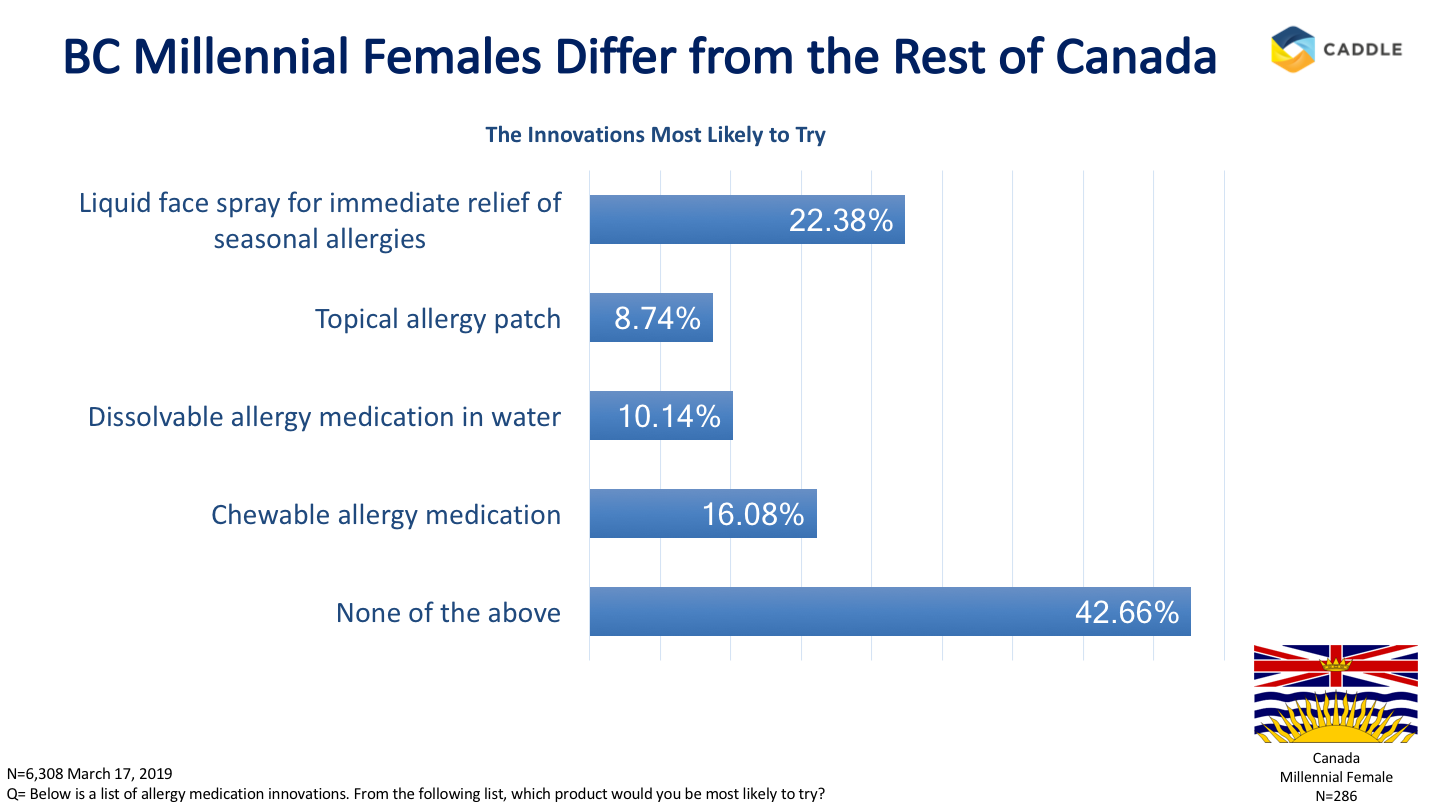
Well according to Global News, BC is seeing the worst allergy season ever in 2019 with Vancouver and Victoria seeing higher levels of pollen than usual. Similarly, “many allergy sufferers are making the mistake of waiting until they are experiencing symptoms before taking allergy medication,” said London Drugs Pharmacist Lily Liange.
On behalf of London Drugs, Insights West conducted a survey and found that four in 10 aren’t taking allergy medications early enough. Perhaps with the higher than usual pollen levels in British Columbia and the finding that individuals are often waiting too long before they start to take allergy medication is the reason why they’re looking for a fast acting, instant relief face spray to relieve them of their allergy symptoms.
Catching some Zzz’s
Have you ever been unable to sleep and ended up popping an allergy pill to help you doze off to a restful slumber? Odds are you’re aware that taking allergy medication makes you sleepy due to the antihistamines in them. But if you’re taking one of these at 3:00 p.m. on a Wednesday, you’re likely in trouble.
Yes, they work but the side effects aren’t necessarily beneficial to our daily routine. That’s why we believe that 39% of our respondents indicated that “product effectiveness” is one of their main purchase drivers when purchasing allergy medication.
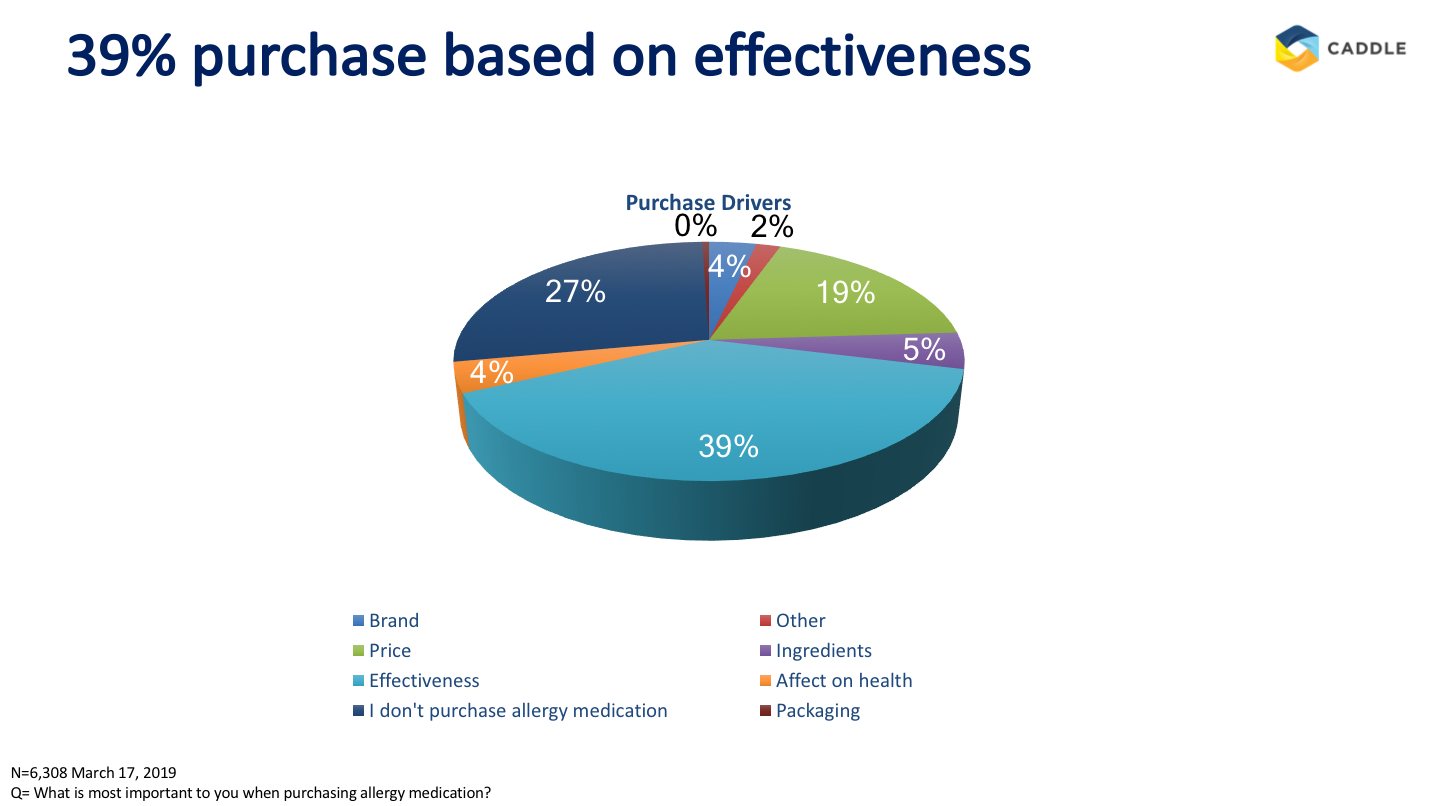
When comparing different brands of allergy medication, Iodine gathered results and found that while users of Claritin, Zytrec and Nasonex reported that the allergy medication is worth it, users followed up with lower results stating whether or not the medication worked well.
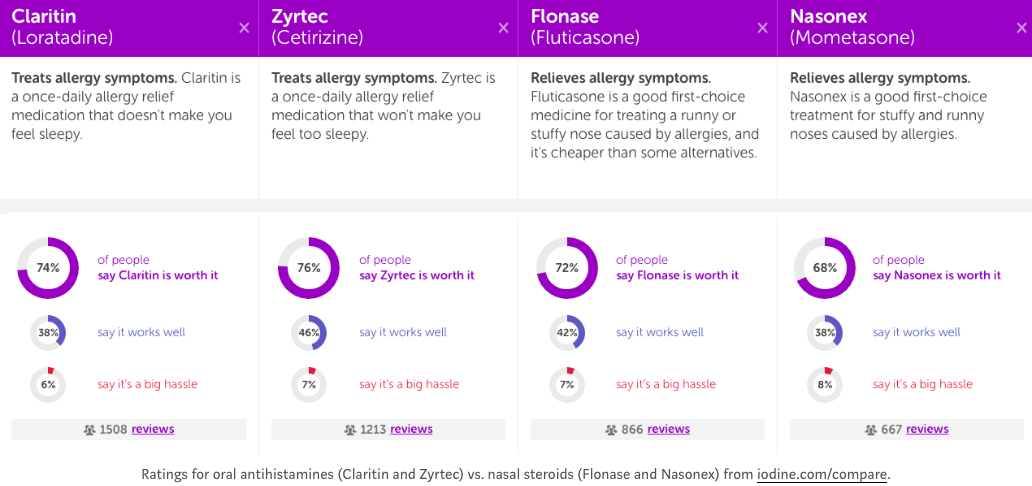
We all want our medication to work, but we don’t want to be face down on our keyboard as the boss walks by. #awkward.
So what?
Allergy season is a time of year that affects many of us. Unfortunately, there is no curable options that have hit the market just yet but there is certainly countless options that can help reduce the symptoms of allergies. Our survey results indicate that there is a high demand for new innovative products that are fast acting and effective. The allergy medication market is in high demand for new medications so perhaps developing a fast acting face spray or chewable medication that reduces symptoms without feeling sleepy afterword s a trend that should be developed.
Caddle is a data insights company that strives to gather insights in the CPG industry to benefit those who are looking for a fast turnaround on what their consumer purchasing behaviours are like. If you’re in the CPG market and are looking to gather insights on your consumers, please feel free to reach out to us.
[simple-author-box]
Drink em' if you got em' - cannabis infused beer
There’s nothing like cracking open a cold one on a hot summer’s day or after a long day at work. Beer is something that we Canadians drink with pride and is ingrained into our identity. Heck – we love it so much we built a beer fridge that opens when we proudly say, “I am Canadian”. With the bubbly beverage being such a large staple in our lives, it only makes sense why the industry is booming. In just one year alone the Canadian beer industry went from 817 to 995 breweries; that’s a 21.8% increase from 2017 to 2018. To further instil beer into our Canadian identity, the industry saw a 0.3% increase in domestic beer sales while import sales declined by -3.4%. That left the entire industry seeing total beer sales as 85% domestic and 15% imported.
Recently, the team at Caddle conducted a survey asking 5,632 respondents about the beer purchasing habits. Let’s crack open these insights and see how they can contribute to the industry.
Cheap and Tasty
Turns out that consumers do care about the taste of their beer and don’t just drink it because everyone else does. When asking our consumers what is most important to them when purchasing beer, 48% of respondents said that taste and price are most important to their purchasing decision. With a 1.8% price increase in beer, maybe buck a beer isn’t such a bad idea after all as some may decide to purchase something else if the price doesn’t meet their budget.
There’s wine connoisseurs so why can’t there be beer connoisseurs? The same ol’stuff can start to taste bland and boring after a while. That’s what appears to have happened to Canadians in the 80’s as they realized there’s more than just Molson Canadian. Outside of Canada there were beers that had more taste and texture with other good qualities as well. This is arguably what started the development of craft beer market. If we’re good at drinking the stuff you darn bet we’re good at making it too!
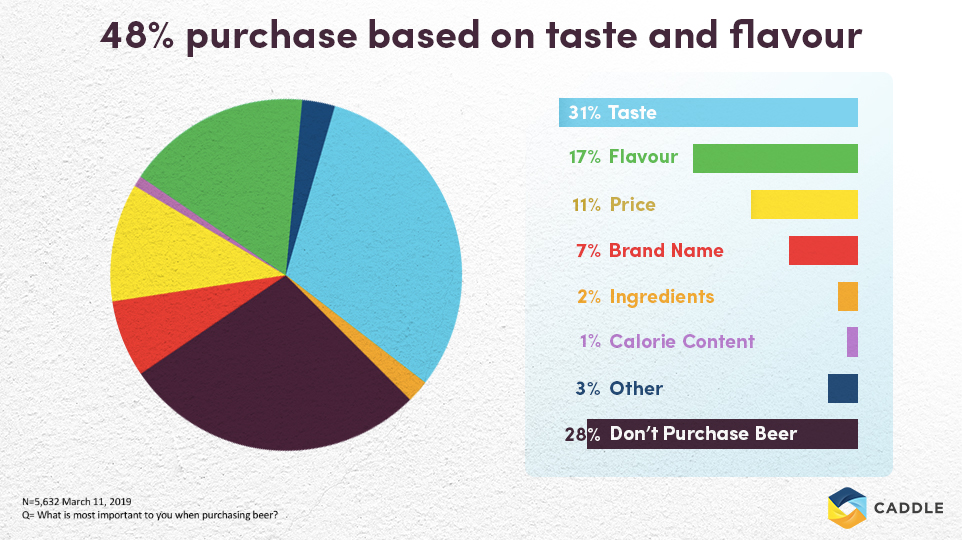
A different kind of wobbly-pop
Since when did the younger generation start getting so responsible? When we asked our respondents what beer innovation they would be most interested in, we found that millennial males in Canada were most interested in cannabis infused beer.
Now, I know what you’re thinking – “that’s not responsible at all!” — but believe it or not, younger people are drinking less and looking for healthier options. They also want to be in control of themselves and not have embarrassing drunk stories told at their wedding in front of their new in-laws. Queue: cannabis infused beer. This innovation acts as an alternative in which cannabis is infused in a non-alcoholic beer where consumers can still get a buzz but feel more relaxed and in control of their actions.
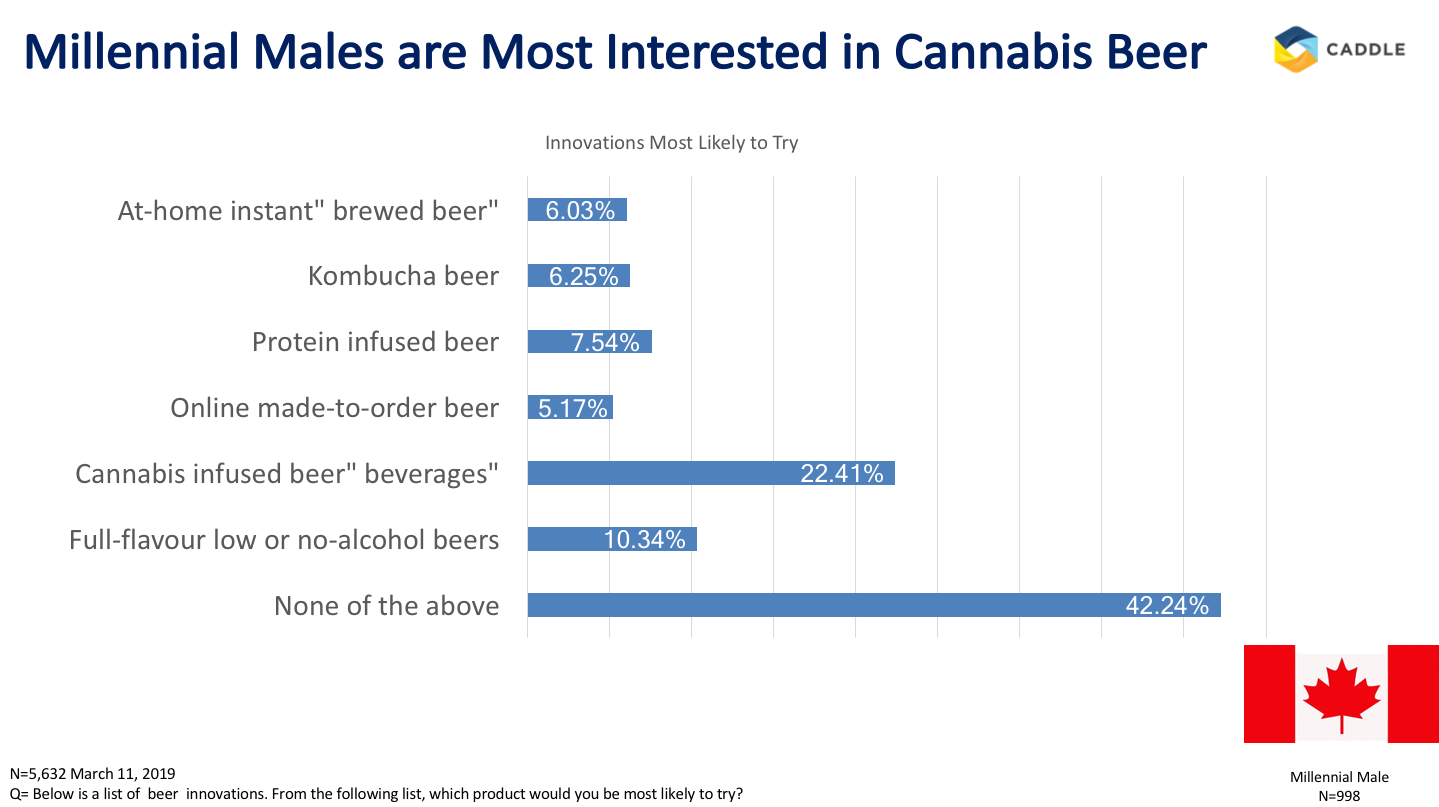
Is that you cuz?
Cannabis and hops are actually distant cousins to each other (huh – learn something new every day eh?)! This is great news because if you’re a millennial male and you’re from Ontario, then you know that beer and cannabis go hand-in-hand with each other. Our survey results didn’t seem to shy away from this fact as millennial Ontarians were most interested in cannabis infused beer when compared to other provinces.
This is worth considering because due to the spike in the Ontario craft beer market, this leaves some left on their own with no future of success since there is simply starting to be too much competition to compete with. If you find yourself in this situation, perhaps cannabis infused beer is the answer. Millennials (especially Ontarian millennials) love the idea, so why not take a chance and see if you can start climbing the ranks to success?
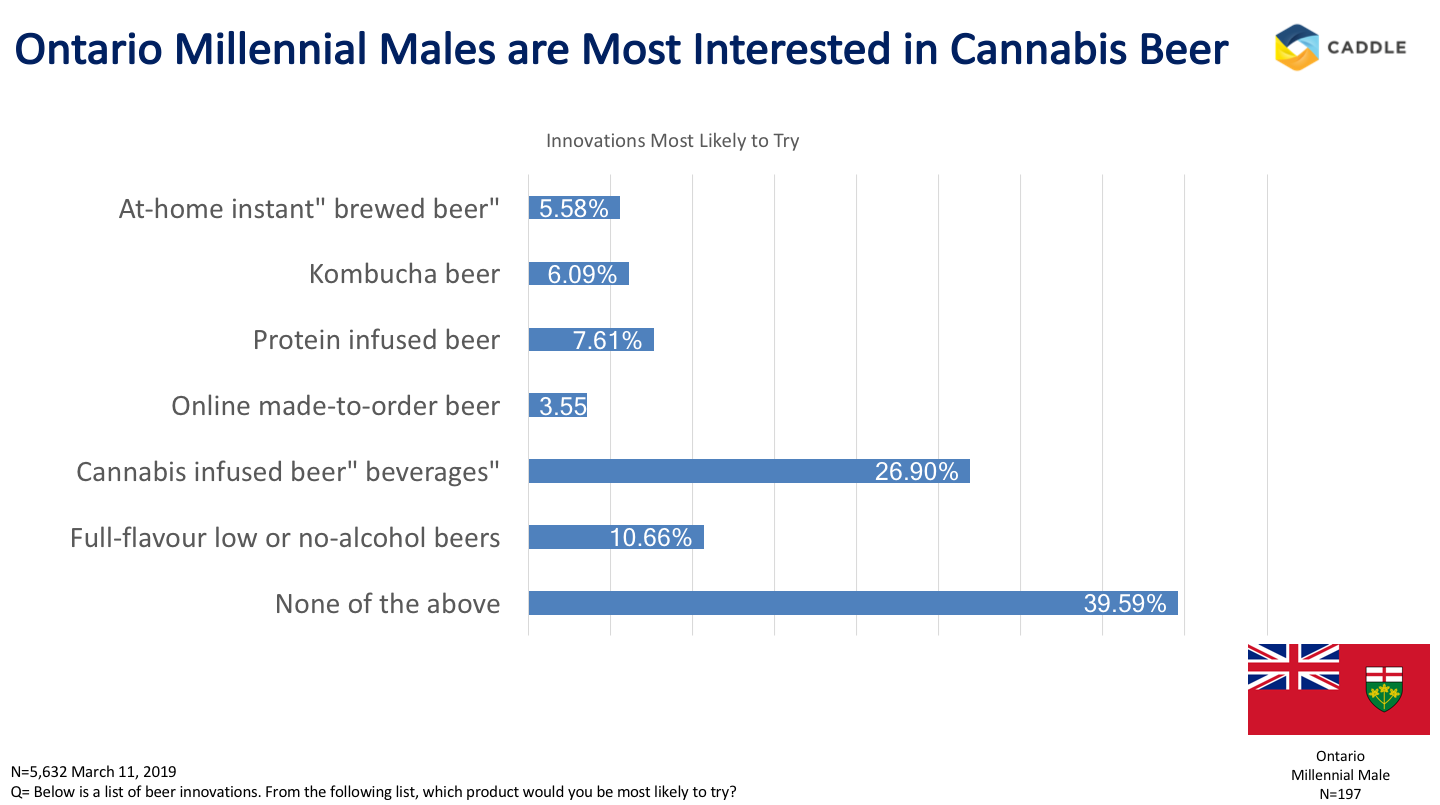
IPA (Insights Provided Accurately)
We showed you the industry and our insights to go with it; so now what? It’s clear to see that the beer industry is a growing one and consumers are looking for more than their everyday kind of beer. They want something that comes at a good cost and taste. If you’re a beer advocate, than you know that beer is a big part of our Canadian identity and it’s fair to say that cannabis is as well, so why not give the people what they want and infuse the two in a socially acceptable beverage?
Caddle is a data insights company that works with a variety of organizations in the CPG industry who are looking to understand their consumers better. If you’ve got questions about your audience and how you can increase revenue, drop us a line and ask how we can help you.
[simple-author-box]
Egg consumption: Our data compared with the industry
The Egg Industry
Who doesn’t like waking up to the smell of bacon and eggs in the morning? Besides, breakfast is one of the most important meals of the day. Whether you have them for breakfast, lunch or dinner, eggs have been a staple in everyday Canadian lives. Recently, we surveyed our users asking them their purchasing habits when it came to eggs. After gathering the results from 7,481 respondents we found that 95% of shoppers purchase eggs while 77% of shoppers purchase eggs often. With a large majority of our users purchasing eggs this reflects well when comparing it to the egg industry itself. 2017 proved to be a profitable year as egg sales saw a 4.1% growth in Nielsen rating sales which was the second highest growth in the past 10 years. The Canadian government also reported a per capita disappearance (food available per person, per year) of 20.2 dozen eggs. The factors that have led to this increase in egg purchases is felt to be due to:
- Shift in consumer attitude toward eggs;
- Shift towards more protein driven diets with egg nutrition offering a cheaper protein source;
- Decrease in cold cereal food availability for breakfast;
- Increased demand for products containing liquid egg whites only, such as yolk-free omelettes and breakfast sandwiches
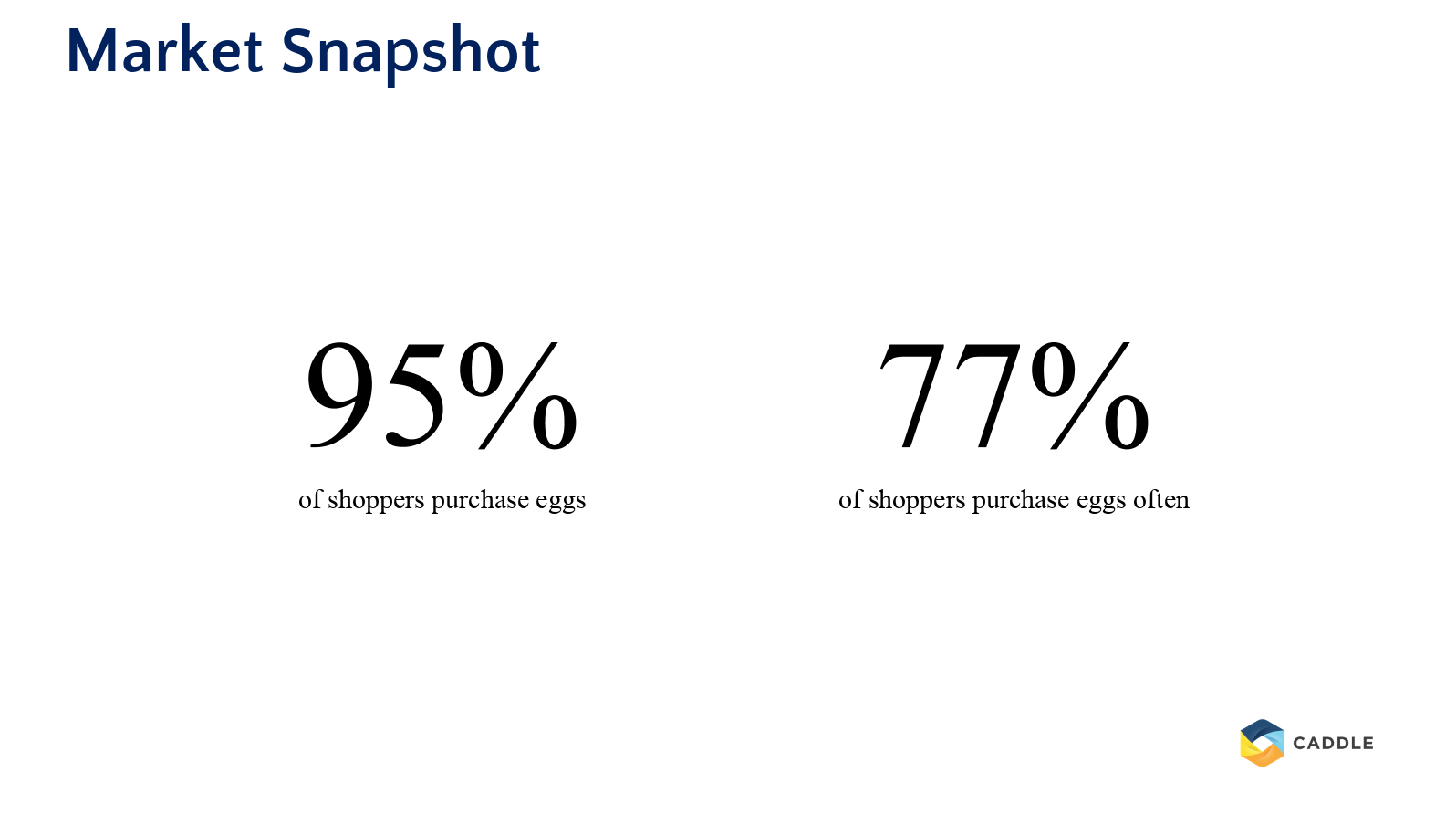
Let’s get crackin’
With the egg industry in Canada showing a progressive rise, we’re intrigued to see what our respondents want the most out of when purchasing eggs. Interestingly, 22.46% of millennial females in Canada indicated that they want cruelty-free eggs. This is something that the Egg Farmers of Canada (EFC) has taken into consideration. With the redevelopment of the national Animal Care Program, the EFC has worked to fast-track the implementation of new housing requirements which guide farmers and align their facilities with the standards of the Animal Care Program. These standards ensure that our egg laying friends are living with the basic needs such as shelter, adequate light and air, a well-balanced, nutritious diet, fresh water and clean surroundings.
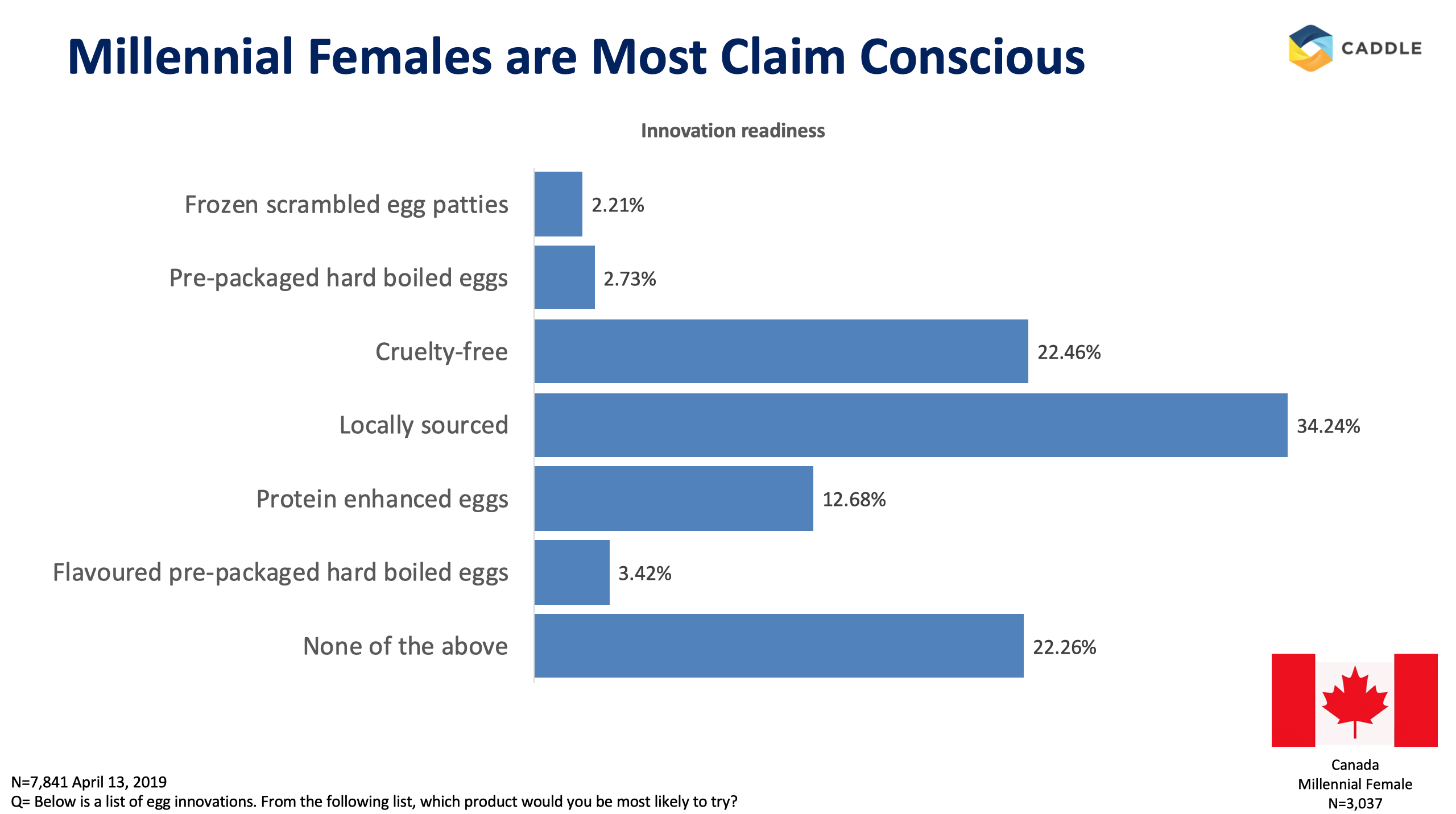
What came first, the chicken or the egg?
In this industry – the chicken (sorry folks). Even though we know that our eggs came from the chicken, a lot of people want to know where their eggs came from. When asking our respondents which egg innovation they would most likely like, 34.44% of millennial women in Canada said that they would like locally sourced eggs. In their 2017 report, the EFC explained that in 2018 they will be printing an identifiable mark on the egg carton. This mark is in line with a new Egg Quality Assurance program which tells consumers that their eggs are produced by local Canadian egg farmers who are producing and have met the highest food safety and animal care standards. So now consumers can be reassured that when they see an egg logo with a checkmark and red maple leaf on their carton, their eggs are Canadian sourced and are of top quality.
White or brown eggs?
Whether they’re large, small, white, or brown all eggs taste the same. Which is likely why consumers aren’t necessarily loyal to one specific brand of eggs. When asking respondents what is most important to them when purchasing eggs, 63% of respondents said they base their egg purchases on price. Similarly, 76.25% of respondents said that they would purchase a different brand of eggs if their preferred brand was out of stock. This is intriguing when comparing the average cost of production and retail price of eggs over the years. The EFC reported that pricing trends in 2017 saw an increase in the average national COP and producer price of eggs while there was a decrease in the national retail price of eggs at $2.48 per dozen. This is something worth analyzing over the years as it might suggest that egg producers will have to make sure that there is an even balance between the COP, producer price and retail price as consumers have noted that they will purchase a different brand of eggs if it doesn’t meet their price range.
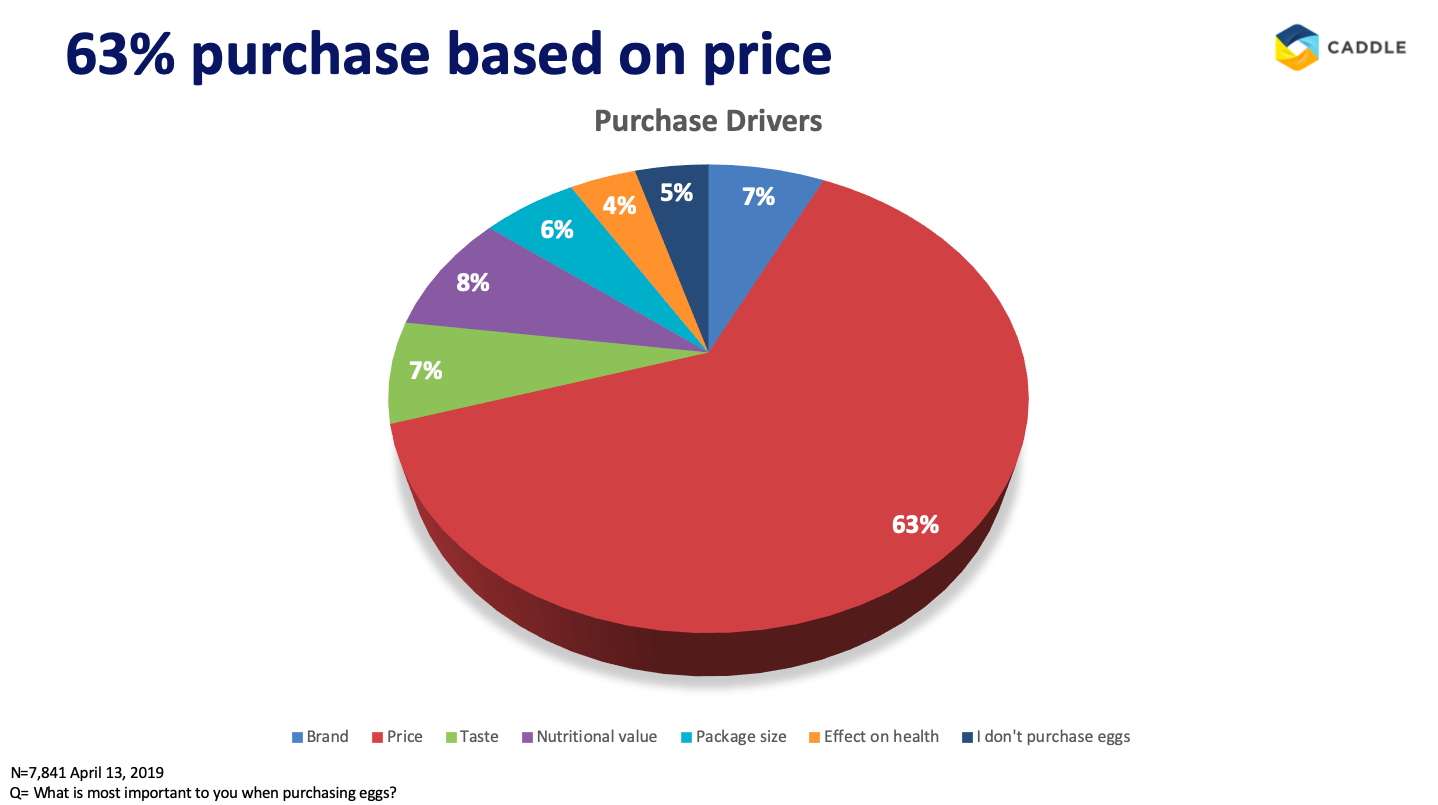
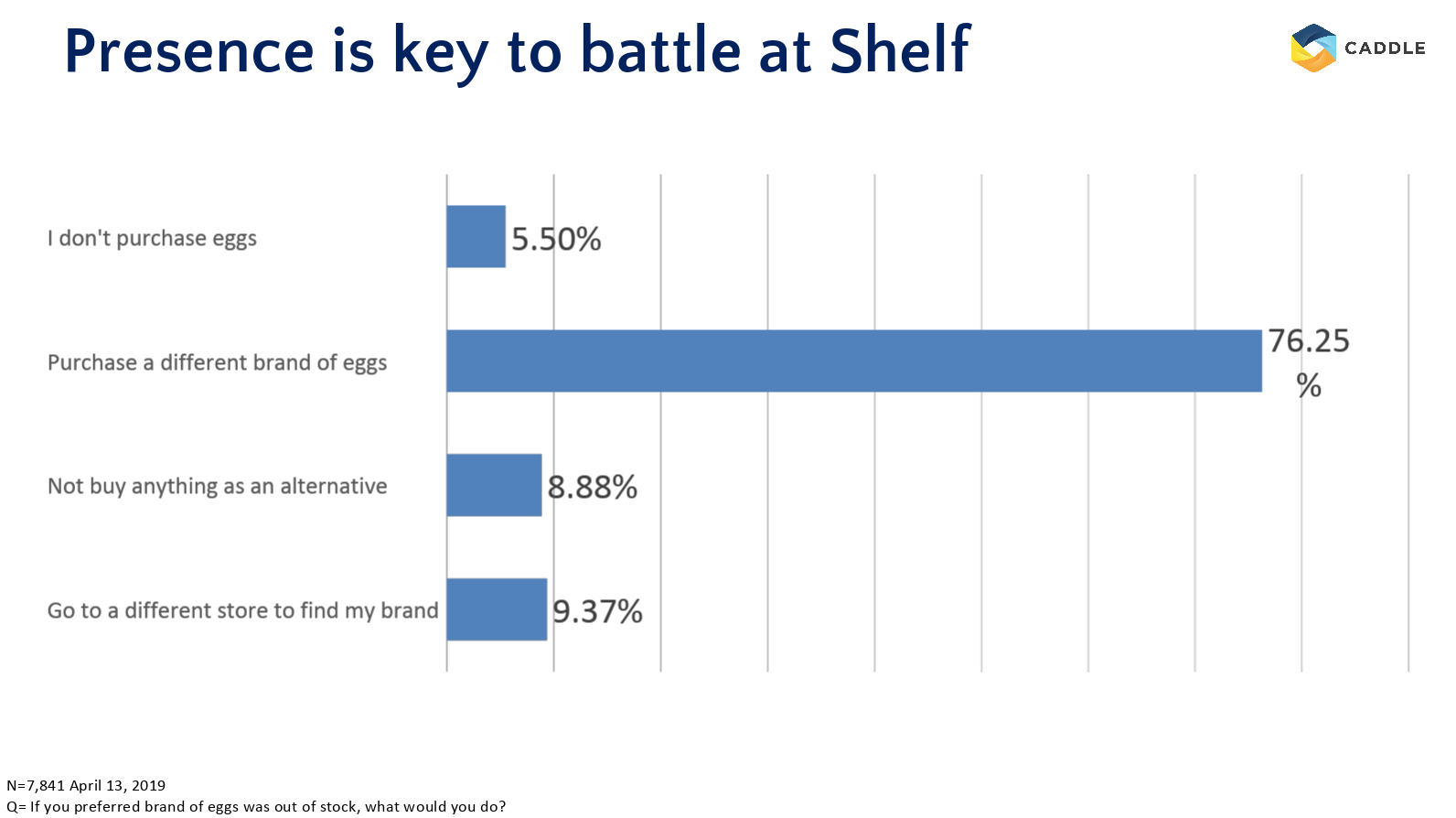
So what?
Caddle is a data insights company that is driven at understanding market and industry trends for the benefit of those in the industry. Our recent survey indicates that egg producers are meeting the wants and needs of consumers purchasing eggs such as providing appropriate living for hens, and informing consumers that their eggs are locally sourced. If you’re feeling scrambled with how you can increase the profitability of the industry you’re in, connect with Caddle to get the data insights you need.
[simple-author-box]
What trends are approaching the soup broth industry?
The Soup Market
Soup – it’s been a staple in our lives from the time we were children. A nice tomato soup accompanied with a grilled cheese, or a hearty bowl of chicken noodle to help fight off a cold. Soup has been around for generations and will continue to be a staple, allowing the opportunity for industry leaders to grow their market share, provided they understand their consumer’s behaviour.
The soup industry is one that has been around for a while with Campbell Soup Company and General Mills Inc. being the industry leaders. While IBISWorld reports a -2.8% decline in total revenue in the United States, as well as a soup sales decline in Canada to $699.9 million in 2017 from $709.4 million in 2012 (reports Financial Post), there has been a growth in the soup industry by 1.6% and projections show the market will have a compound annual growth rate of over 4% by 2024.
Hearty Data
Here at Caddle we conducted a survey asking over 10,ooo of our consumers their soup broth purchasing habits which we believe could help explain the current soup broth industry and forecast how it could be improved upon.
For starters, when we asked what is most important when purchasing ready to use soup broth, 35% of our members agreed that taste and flavour was the driving purchasing decision while there was an over-indexing score of 38% when targeting Gen Z consumers. This is interesting as global flavours such as Campbell’s introduction to Pho broth have become a popular choice. With the introduction of popular broths entering their product lines it’s also important to remember that “consumers want their food to be made with recognizable, desirable ingredients,” says Melissa Mendoza, director of marketing for Campbell Canada.
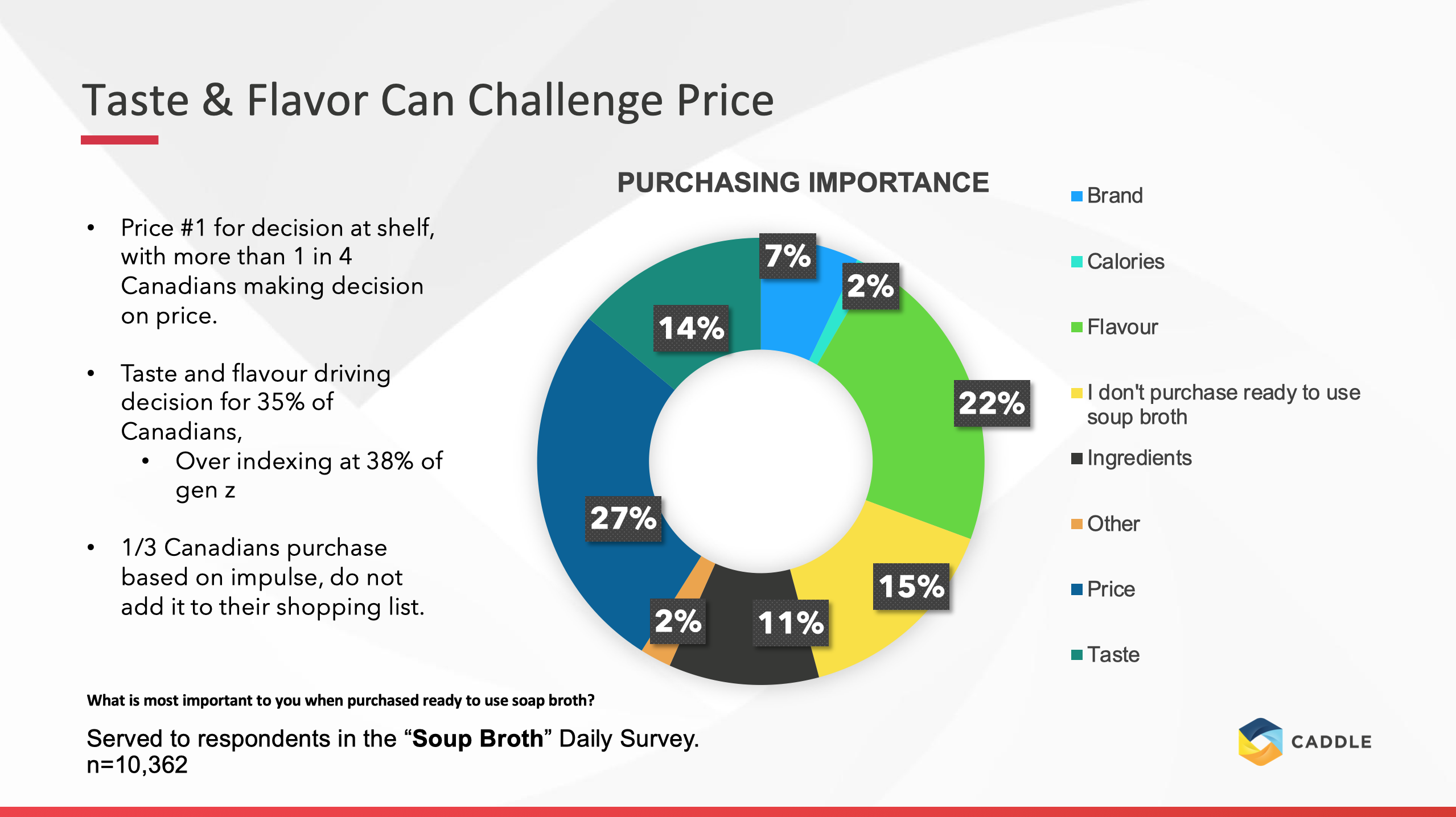
Soup Innovation
With the Millennial and Gen Z generations making their way to being the majority population, the soup industry may want to consider some newer innovations to increase revenue. To adhere to the demographics wants, Campbell’s has reduced sodium, added vitamin D to their condensed soups and only added ingredients that people can actually pronounce. While this is a step in the right direction to generating more revenue, our survey offers another innovation as well.
When presented with a list of options, we asked our members what product they’d most likely like to try and 30% of members said that they are interested in ready-to-drink chicken bone broth. While we thought this was surprising, after further research we found this data to be accurate when we discovered a +100 search intent on Google Trends. This new innovation is one that is on the rise in popularity for its collagen benefits, support in digestive health and arthritis relief. With a younger demographic wanting healthier options in their soup, perhaps bone broth is one innovation to consider.
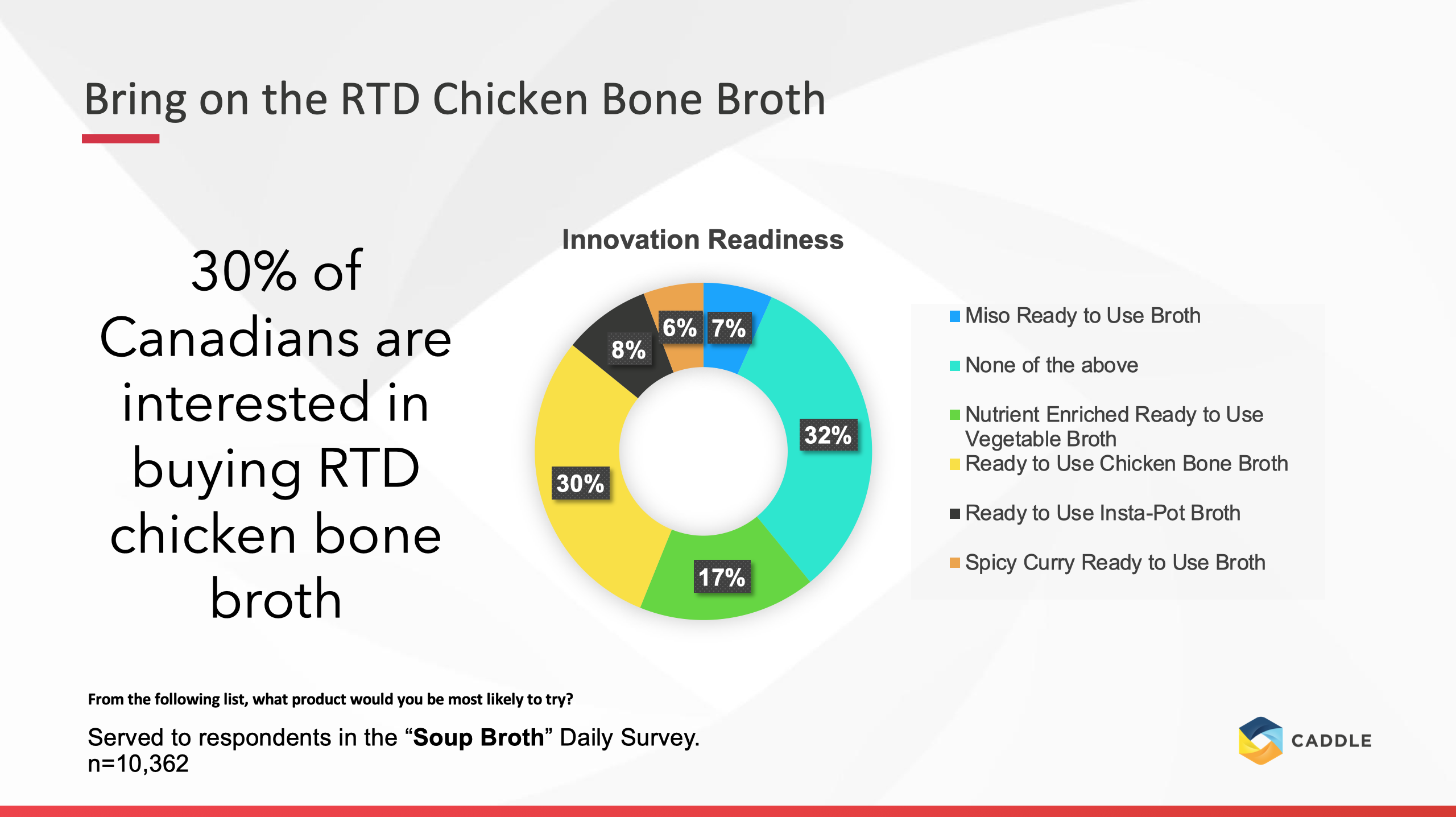
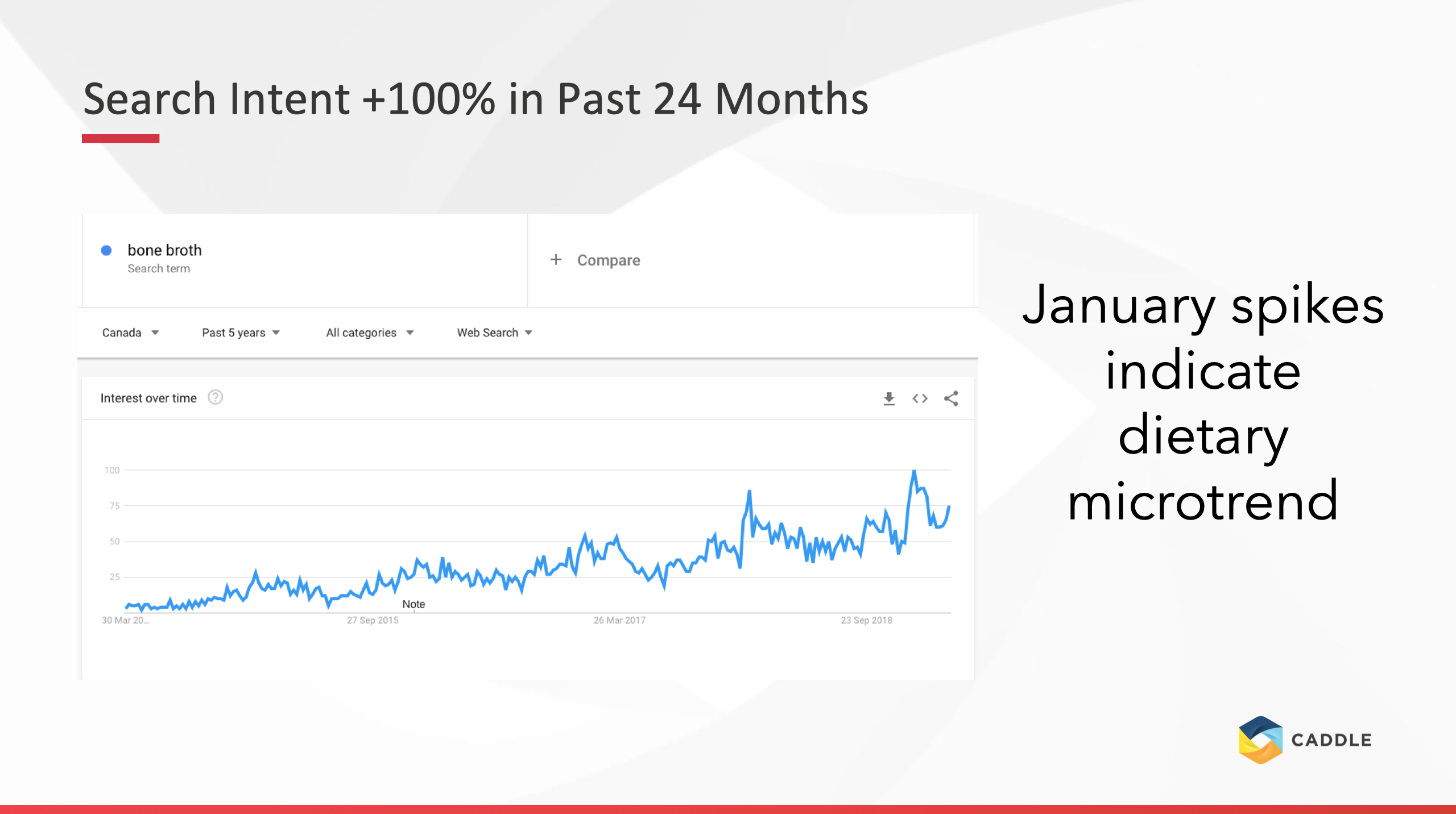
Brand Loyalty
When you think of a soup brand perhaps one of the first brands that come to mind is Campbell, Knorr, or Progresso. But much to our surprise, we found that 1/3 Canadians are loyal to their broth brands. So how might a company in the industry increase brand loyalty? For starters, since the soup broth market projected to increase over 4% by 2024 this offers the opportunity for new entrants to be entering into a lucrative industry. On the other hand, this could also create significant competition between industry leaders and new entrants. Therefore in order to generate brand loyalty, it may be important for production companies to consider creating healthy broth alternatives such as lower sodium broths or ready-to-drink bone broth.
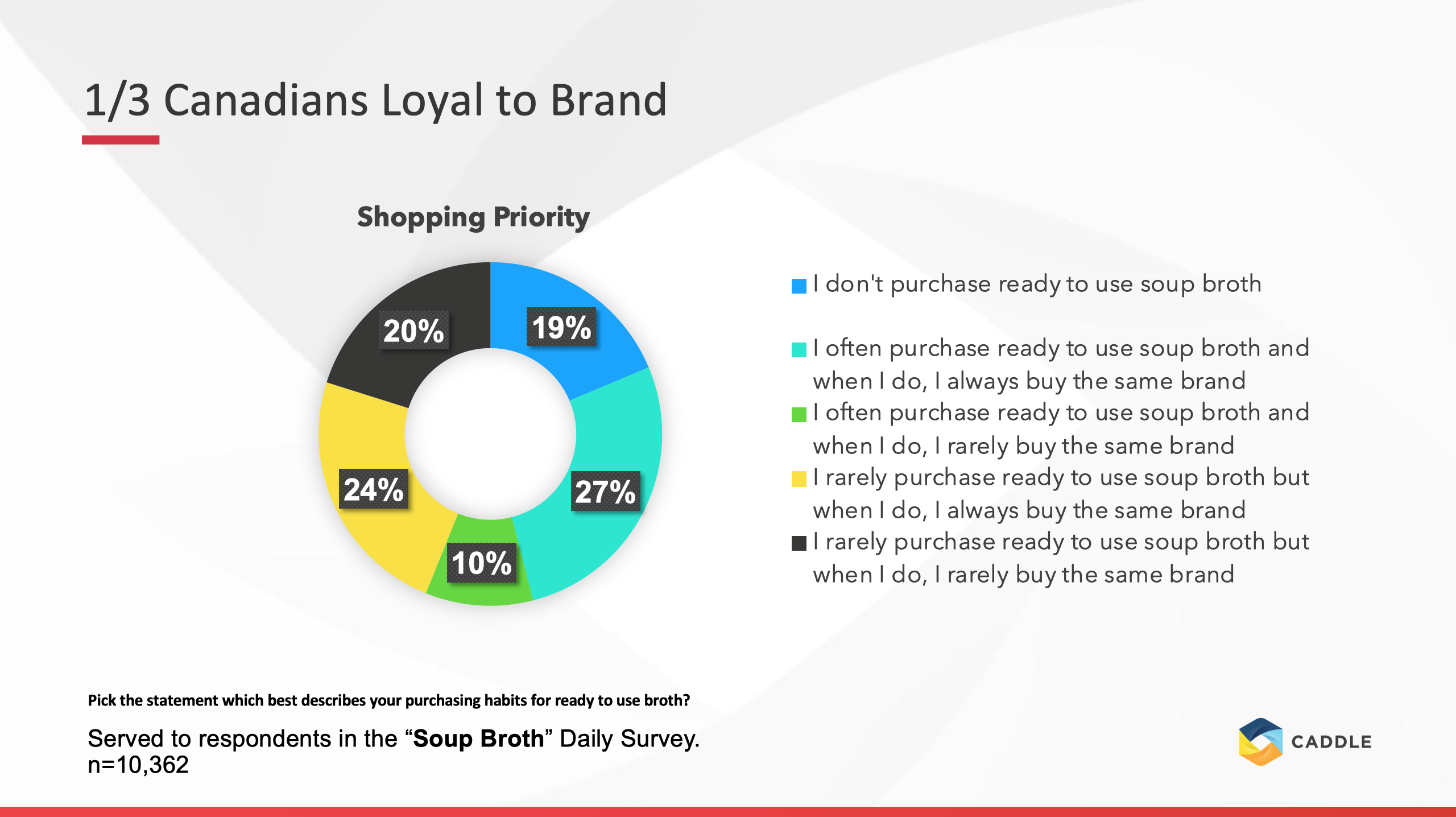
Now What?
Soup has been our lives since as long as we can remember, everyone loves a good soup and sandwich. But no one likes working in an industry that doesn’t know their demographics wants and needs. That is where Caddle steps in. We provide industry leaders with insights that will help them understand market trends and how they can increase revenue and brand loyalty. If you’re a soup broth industry, our insights suggest that there should be a continued effort to create broths that are flavourful and healthy. By creating a flavourful broth that attributes to the health trends such a bone broth, this could allow for the potential for consumers to regularly buy the product and in turn, increase brand loyalty.
[simple-author-box]
Price, taste and innovation: what's in your breadbasket?
The Bread Market
We all have a love for bread (maybe a little too much), and the global trends certainly appear to reflect that as the global bread market was valued at $201 billion USD and is showing no signs of a plateau in the coming years. Diving a little further into that figure and zeroing in on our homeland, Canada’s bread production industry has a collective of $8 billion CAD while showing an annual growth rate of 2.4%. While this is a flourishing market both globally and continently, recent market trends seem to show that consumers are looking for more healthy options as to avoid looking too doughy themselves. This would encourage the production of more nutritious, specialty and artisanal breads.
The Facts
This is all very interesting to us as some of these trends appear to correlate with our survey findings. When asking consumers to select a statement that best describes their bread purchasing habits we found that 95% of people buy bread (I know, shocking right?). But as anticlimactic as this might seem, this is actually very intriguing considering the steady rise of bread (pun intended). When observing the market trends with regard to the price of bread, the prices are now 70.39% higher since 2000 with an average inflation rate of 2.84% per year; meaning that a loaf that would normally cost $5 in 2000 would now cost $8.52 in 2019. But what does this mean for the industry leaders? Well you better make sure that your brand is on the shelf because 66.88% of people said that they would purchase a different brand of bread if the one they normally purchase wasn’t available. Similarly this could mean consumers aren’t entirely loyal to their normal brand of bread and if there is a cheaper option available they could be likely to put that one in their basket instead.
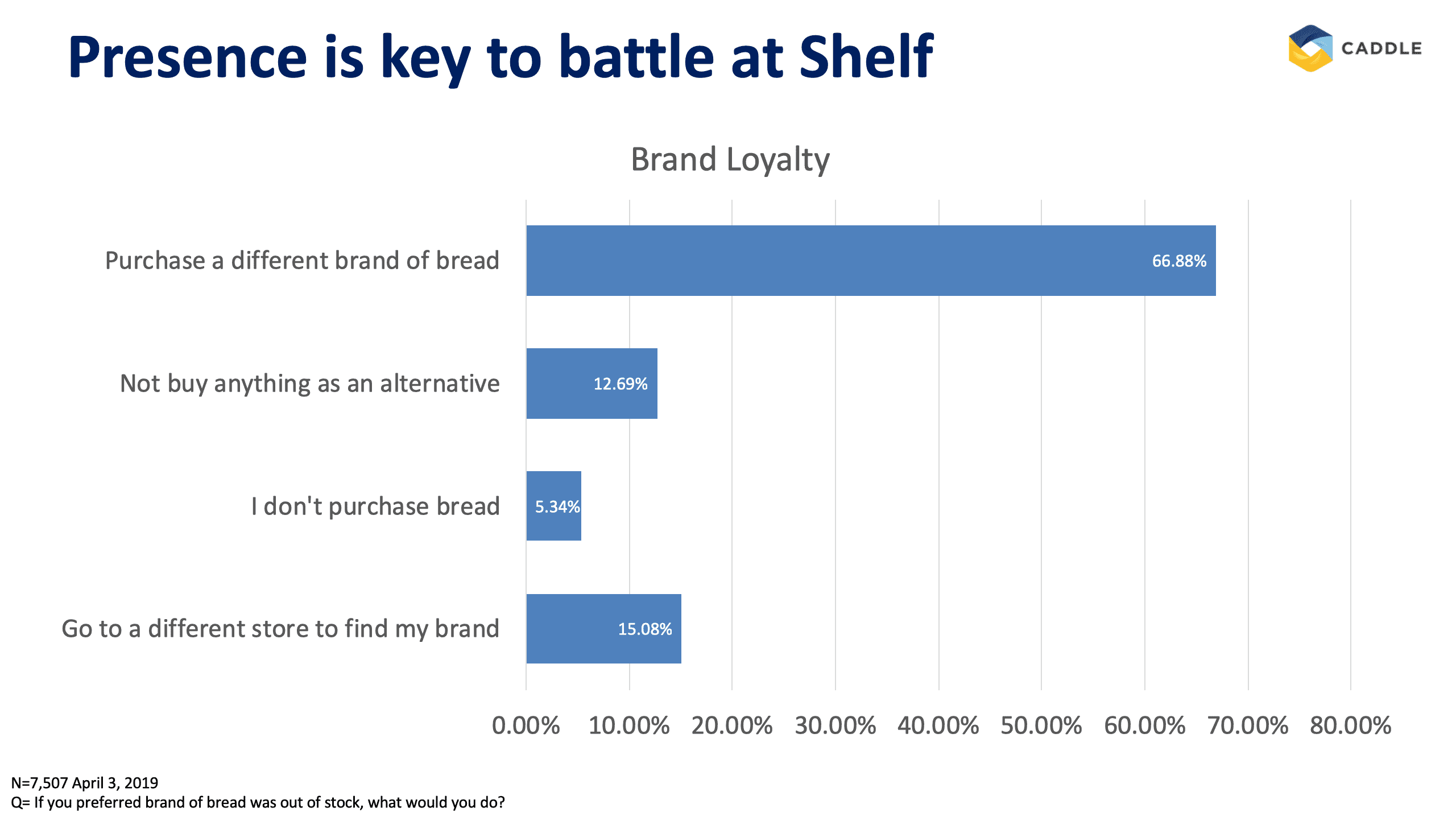
The best invention since sliced bread
Who doesn’t love new innovations? They make our lives easier without even realizing that the normal way of doing things was problematic. When it comes to bread there is nothing more frustrating when you’re making the dream sandwich only to find out that your delicious bread is moldy and you’re forced to throw out the bread. Food waste has become a real issue with reports of 1/3 of food produced goes to waste and equates to $1 trillion wasted globally. Comparably, our survey results indicate that millennial females are most interested in purchasing half loaves of bread. While this innovation isn’t a solution to all food waste, it’s certainly one that is plausible as half loaves have been available in the European market for quite some time. To further this idea, our Ontario demographic stated that 1 in 4 females would be interested in purchasing half loaf bread. This appears to align with market trends as Supermarket News states that while bread remains a staple, people are consuming less of it. Perhaps by then having the option to purchase half loaves of bread could help contribute to the prevention of food waste and align with the trend that bread just isn’t being consumed in the same quantity anymore.
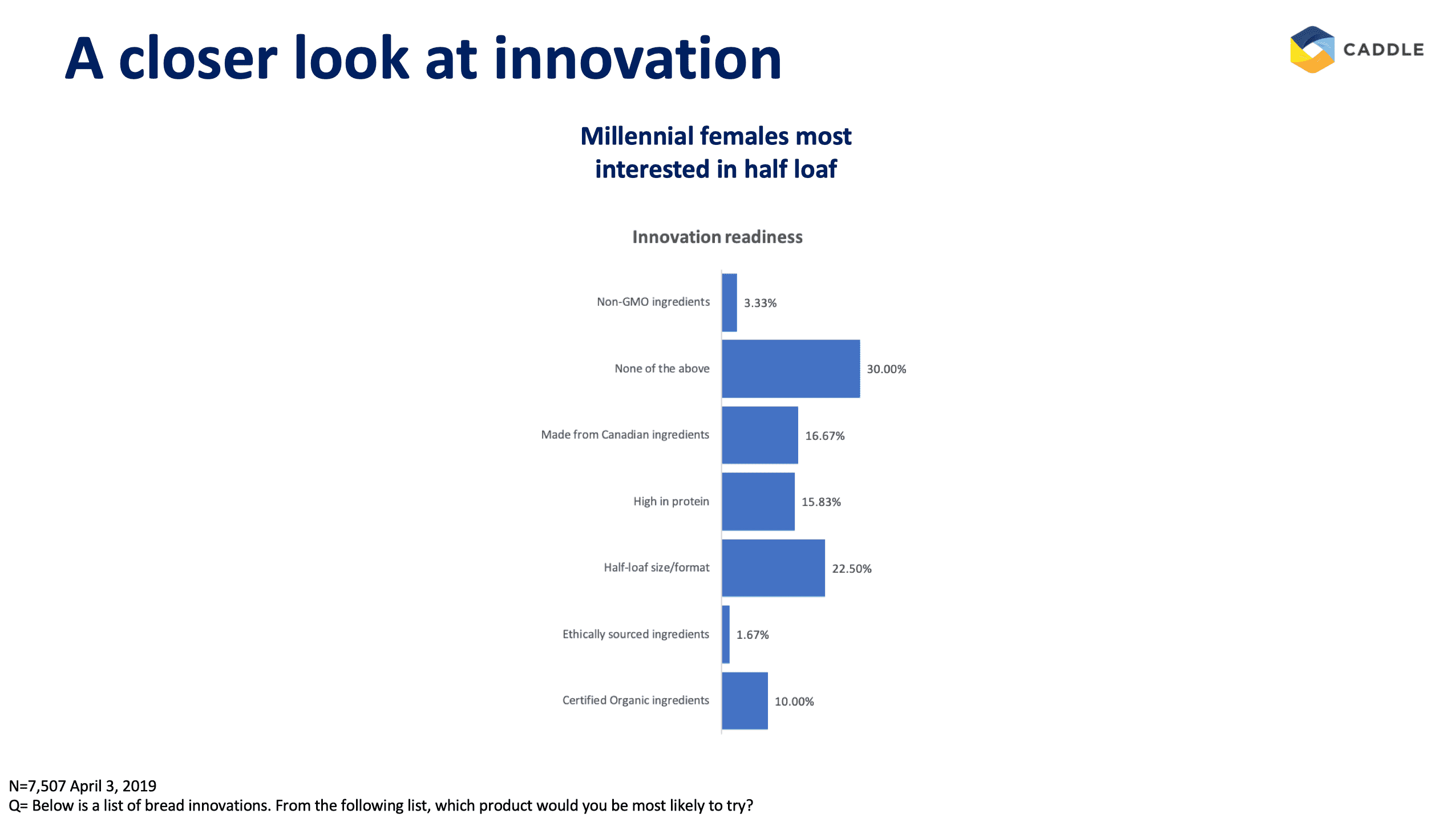
Great taste at the right price
It’s fair to say that every purchase we make we want the most bang for our buck. So why should we have to sacrifice taste for the price of bread or vice versa? That’s something that struck with our respondents. 59% of our users said that their bread purchases are based on the price and taste. This again correlates with the research done by Supermarket News as they found that two-thirds of their respondents stated that price is the most important attribute when purchasing bread while taste placed second with 57% of respondents citing taste as the second most important attribute when purchasing bread. As much as we love the smell, taste, and comfort bread brings to us, it still seems to have a negative image due to its health aspects. With the high levels of carbs, sodium and fat levels “operators have had to scramble to keep up with changing fads like low-calorie, whole grains, artisanal and gluten-free [breads]” says Supermarket News. For industry leaders knowing what consumers want such as well priced, tasty and healthy products, this is the daily bread that keeps the company ahead in the market.

So what?
Based off of our results from respondents, we can see that a large majority of consumers are purchasing bread but there are certain aspects that determine their purchasing habits. Consumers want bread that is well priced, tasty, healthy and quantifiably efficient. Aside from half loaf of bread, our Canadian consumers also reported that they are interested in innovations such as high protein bread and Canadian sourced ingredients. From the quick survey that we had our consumers respond to, it’s evident to note that our findings align with current market trends. That is why we strive and have the passion to work with market leaders to help them understand their consumers purchasing behaviours in order to increase the industry leaders revenue and brand loyalty.
Who Are We?
If you’re unsure by now, Caddle is a data insights company that has a passion for understanding market trends which can be translated to the market industry leaders for the benefit of understanding the buying behaviours of their consumers. Most recently Caddle conducted a survey with a sample size of 7,507 respondents in which we asked consumers their buying decisions when it came to bread. Given today’s market trends, we found the results to be quite interesting and we hope you do too.
[simple-author-box]
How to plan your time in San Francisco to make the most of your trip
Travel San Francisco
Home to the iconic Golden Gate Bridge, a booming, culturally diverse metropolis, vibrant food, arts, entertainment and night life scenes, a waterfront that attracts fishermen and tourists from afar and so much more, San Francisco is full of wonders. It’s also got a reputation as one of the most expensive U.S. tourist destinations you can visit. Luckily, we’ve done our homework, and are ready to help you save on accommodations, places to eat, attractions, and more.
Geography, population and more
San Francisco, California is located on a peninsula between the Pacific Ocean and San Francisco Bay. One of United States’ most cosmopolitan cities, it’s under 50 square miles and has a population of just over 800,000 (making it the fourth largest city by population in California).

Currency and budget
Exchanging your Canadian currency for American dollars before your trip is the cheapest way to do it, since you can shop around for the best currency exchange rates, says Nerd Wallet, which breaks down where you can exchange without paying huge fees. If you wait to do it at an airport kiosk or somewhere else, fees, delivery charges and poor exchange rates could eat into your budget.
The Broke Backpacker ballparks a budget of between $70 and $85 USD ($93 to $113 CDN) per day, though they say you can get by on as low as $25 to $30 USD ($33 to $40 CDN). Budget Your Trip, which publishes average travel costs for thousands of cities around the world provided by other travelers, is in line with that range, pegging average daily cost per person per day at $68 US ($91 CDN) if traveling on a budget. According to the website, a couple could spend a week in the City by the Bay for just over $950 US ($1,274 CDN). There’s also a breakdown for accommodation, food, entertainment and other expenses.
It’s also worth it to skim The Baller on a Budget’s three-day guide to San Francisco on a budget. It’s packed with tons of great ideas for cheap places to eat, popular places to go, and more.
Save money with attraction passes
The San Francisco CityPASS (which you can buy online or at the box office of any attraction on the ticket) gets you:
- a seven-day Muni Pass good for unlimited rides on the cable car, historic trolley and other public transport
- a San Francisco Bay cruise
- entrance to either the Exploratorium science museum OR de Young Museum of Art + Legion of Honor
- entrance to California Academy of Sciences
- entrance to Aquarium of the Bay
You can also pick up the Go San Francisco Card, which can get you into 28 attractions such as:
- Hop-On Hop-Off Sightseeing Bus Tour
- Madame Tussauds
- The San Francisco Dungeon
- Ripley’s Believe It or Not!
- San Francisco Zoo & Gardens
- and more
If you’re visiting San Francisco for the first time, picking either of these passes can help you save money on popular tourist attractions and make planning your itinerary a bit easier.
When to go
If you’re hoping for clear, mild weather and fewer crowds, hotel expert Santorini Dave advises making the trip in the spring or fall – May, June, September or October. Avoid the winter, which is bound to be chilly and damp, and the summer, when you’ll see prices climb and more tourists flood the attractions. Dave has a good rundown for when to go depending on whether you want to sightsee, shop, stroll the Golden Gate Bridge, visit Pier 39 and more.

Where to stay
Though inflated prices might make you think twice at first, there are also cheaper accommodations. Affordably priced hostels, couch surfing hosts and (if you’re feeling extra adventurous) semi-urban campgrounds await. The Broke Backpacker says you’ll find most hostels are high-quality and reasonably priced, around $20 to $25 USD ($27 to $33 CDN). USA Hostels San Francisco is consistently voted as the best hostel in the city on hostelworld.com, with a well-designed and maintained property, free daily breakfasts and free dinners on Monday and Friday, plus a yoga room.
Lonely Planet also has a list of quirky motels, great hostels and cute guesthouses, from Hi San Francisco Fisherman’s Wharf hostel on the waterfront for $32 USD ($43 CDN) per night to the San Remo Hotel in North Beach for $88 USD ($117 CDN) per night, you’ve got options. Be weary of traditional hotels, though – at the time of this writing (early April 2019), a booking.com search for three-star hotels available the week of May 6, 2019 revealed prices anywhere from $200 to $400 USD per night per couple with no children for one room (switch the currency converter at the top right of the screen to reveal Canadian rates).
Also, Airbnb was founded here. If you’re looking for an authentic San Fran experience, this is the way to go.
You can also check out Rough Guides’ article Where to stay in San Francisco: an area by area guide.
Passport and safety issues
When entering the U.S., you’ll need to provide proof of your Canadian citizenship and your right to return to Canada (The Government of Canada says a Canadian passport that’s valid until the date of your intended departure from the United States is best, although you can also use several other documents). In most cases, you won’t require a visa. See travel.gc.ca for more about entry and exit requirements.

Safety
When traveling to the U.S., all the traditional safety precautions you would in any other country, like keeping close track of personal surroundings and watching out for petty theft, pickpocketing and credit and debit card fraud.
The probability that you’ll be a victim of a violent crime such as a mass shooting is low. If you are threatened by robbers, stay calm and do not resist, and lock windows and doors securely whether you’re staying in private or commercial accommodations.
Flights and transportation
Flying into San Francisco, you’re likely to land in one of three major airports:
1) San Francisco International Airport (SFO) – San Mateo County
2) Oakland International Airport (OAK) – Oakland
3) Norman Y. Mineta San Jose International Airport (SJC) – San Jose
CNN Travel has a great rundown of each airport and what to consider before you decide which one to fly into.
As for flights, Adventures with Luda recommends adding San Jose Airport and Oakland International to your list when reviewing airports to save some cash. You can also try flying mid-week and shopping around for best deals – take a look at Google Flights, then head to Skyscanner or Momondo to book.
Public transportation
TripSavvy advises against renting a car if you’re seeing the sights in the city due to high rental costs and most attractions being so close to one another, since the city is only 49 square miles.
A Muni Passport costs about $10 and is good for unlimited travel on the cable cars, historic streetcars and buses. While it’s included on some of the discount attraction admission cards, you can also purchase them separately at specific locations, although travel blogger Whimsy Soul says it’s hit or miss, adding it’s easy to head West to East across the city, but difficult to go North to South. Instead, she recommends taking Uber Pool (Uber’s carpool option) or Lyft Line to most places, since the fares are cheap. San Francisco is also a walkable city.
Another option is to take the Bay Area Rapid Transit (BART), which connects the San Francisco Peninsula with Berkeley, Oakland, Fremont, Walnut Creek, Dublin/Pleasanton and other cities in the East Bay. Kids 4 and under ride free, but everyone else must have a valid BART ticket or Clipper Card. Because fares are determined by distance traveled, time-based passes (weekly or monthly) are not available. Plan your trip and travel costs on BART using their fare calculator.

Where to eat
You won’t leave San Francisco hungry, even if you’re here on a budget. The city has an eclectic mix of options for everyone from fresh fish eaters to Chinese food lovers, food truck aficionados and farmer’s market browsers.
Visiting the waterfront? Free Tours by Foot recommends lunch at The Codmother. Though your journey will take you a few blocks away from the tourist trap restaurants, they say it will be worth it, as amazing fish and chips await. They come right off the boats at Fisherman’s Wharf! Free Tours also suggests getting the junior size, since the regular size is huge.
If you’re hankering for street food, Whimsy Soul suggests heading to food truck park SOMA Eats or to Off The Grid, food truck pop-ups with live music (bring cash). There’s a hot debate among locals about who has the best pizza – Tony’s Pizza or Pizzetta 211. She also has favourite places to grab brunch, drinks, coffee and more.
Of course, San Francisco has plenty of lounges and dance clubs with more than a few alcoholic drinks to choose from if you’re looking for a fun night out. Cider enthusiasts will enjoy Upcider, where you can get a flight of ciders and taste test different variations. Ordinary Traveler gives a thumbs up to the food here too. Over at Infusion Lounge, you’ll have fun dancing the night away and sipping moderately priced drinks. You can sign up for their guest list online and get $10 off your cover charge. Even better, at Temple Nightclub, you can do the same and get free admission.
Dining In
Looking to shave some expenses? Cook at home. Getting up early one Saturday morning to visit the iconic Ferry Building that houses one of the city’s best farmer’s markets (a hallmark of the city’s organic food scene) will be worth it, raves travel blog The Planet D.
Tip: Chinese food is very good in San Francisco and tends to be less expensive than other choices. – TripSavvy
You also might have heard about Chinatown – one of the city’s most iconic neighbourhoods. Venture here and you’re in for a treat. You’ll find everything from My Canh’s late night Vietnamese to the best egg tarts in town at Golden Gate Bakery, classic and spicy Sichuan at Z & Y Restaurant (which has welcomed President Barack Obama, living Chinese legend Cecilia Chiang and others), and even delicious blue collar fare at New Lun Ting Cafe. Eater San Francisco has a great guide for where to eat and drink in Chinatown featuring these places and several more.

What to do
See Pier 39 and the amazing waterfront
Every great major city has a waterfront with stunning views, and San Francisco is no different. Although it’s one of the area’s most popular tourist attractions, there’s also lots to see and do there, including sea lions, Bay cruises, jugglers and magic shows, several shops and places to eat, rides, and gorgeous waterfront views. Fog City Secrets has a detailed rundown of Pier 39 from a local’s point of view.
Appreciate street art
You’ll see signs of San Francisco’s thriving arts scene everywhere – no need to set foot inside a gallery. In fact, some of the most vibrant murals are just waiting to be discovered at Clarion Alley in the Mission and inside the Coit Tower. Though these are a couple of the most popular sites for street art, you can find murals across the city, says The Culture Trip.
Visit Union Square
Whether you’re looking for theatre, shopping, galleries or hotels, it’s all in San Francisco’s Union Square. This is true old San Francisco, with all the cable car photos, speakeasies like Bourbon & Branch, historic buildings and vibrant nightlife you could want. And if you’re a clotheshorse, Union Square is a rite of passage, notes Viva Lifestyle and Travel in its no-nonsense guide. Just keep in mind: homelessness is also prevalent here, so always beware of your surroundings as street characters mill about (usually minding their business).
See Golden Gate Bridge and park
Did you know you can walk or bike across one of San Francisco’s most recognized landmarks? Golden Gate Bridge – opened in 1937 and an enduring engineering marvel – is stunning at any time of day, but if you make a day of it, you can also take time to explore Golden Gate Park, a magical place with something for everyone, from the Conservatory of Flowers to the California Academy of Sciences, a carousel, aquarium, Japanese Tea Garden, and more.

Explore Alcatraz
Alcatraz is on most everyone’s list of must-see places in San Francisco and for good reason. Although the former federal prison on Alcatraz Island was closed in the 1970s, it still holds allure as a national landmark. As Nomadic Matt notes, it was home to some of the worst criminals in the United States! Book your spot on the ferry early if you’re visiting in summer, since it fills up fast.
Looking for even more ideas? See TripSavvy’s 18 free things to do in San Francisco.

Don’t forget to tell us about your experience! Have you ever traveled to San Francisco, or are you planning to book a trip? What are your best tips when it comes to saving for vacations? We’d love to hear what you’ve planned, or any tips we’ve missed. Share your story in the comments and tell us what destinations are on your wish list. Our team love saving for holidays and we hope to inspire our members with exciting suggestions to spend your Caddle money.
How to set up a Shopify store
Why Shopify?
You’ve got an innovative new product idea…now you need to set up your online store so your customers can find you and you can start selling! Shopify is a great choice and it’s one of the most robust eCommerce platforms you can be on today. In about 20 minutes, you can set up a Shopify store, no coding or web development experience required. Bonus: the ability to scale your product line as you grow.
In this article, we’ll show you how, from the first time you sign in to launching your brand new site.
Fast facts
Powers: 800,000+ merchants
Subscription fee: $29 USD per month for Basic Shopify (best for new businesses)
1. Sign up
Go to Shopify’s website and click the Start free trial button. You’ll be taken to a page where you’ll fill in your email address, and create a password and a name for your store. When complete, click the Create your store button.
On the next page, you’ll answer a couple of questions about your business. If you’re setting up a store for a client, click the checkbox beside “Yes, I’m designing/developing a store for a client.”
Enter your business address on the next form, then click the Enter my store button.
2. Add your products
Shopify provides a smooth on-boarding process that gets you ready to sell online. Try their suggested tips to get started, including adding products. These can be “physical items, digital downloads, services, or anything else you dream up,” says the description. Fill in product title and description, availability, pricing, and other information. You’ll also fill in inventory and shipping information here. Don’t forget to save your product.

3. Choose a theme
Back in your main dashboard (click Home in the menu on the left to get there), hit the Customize theme button to visit the Themes page, where you can explore Shopify’s free themes and browse the Theme Store, which offers free and paid themes. You can also upload a theme’s .zip file here. Press the Customize button and you’ll be able to edit each section of your theme, from the header to the footer. No need to worry about photos; you’ll have your choice of several categories of free images – everything from Women’s and Men’s Fashion to Nature, Accessories & Jewelry, Work & Productivity and many more.
Tip: You can also get to the Themes section by going to the Sales Channels menu and choosing Themes.
4. Add blog posts and pages
Under Sales Channels, you can add Blog posts and Pages. While blog posts are a great way to build your community, pages with clear titles and descriptions improve your SEO (search engine optimization) help customers find your site.

5. Buy your domain
Now that you’ve added your product(s), chosen a theme and done some customization, it’s time to choose your domain before officially launching your site. Back to the dashboard again. Your current domain is whatever domain name you chose back when you signed up, but here you can add a custom domain to strengthen your brand and help customers find your store.
Click the Add domain button and decide whether to:
- connect an existing domain
- transfer a domain
- buy a new domain
- If you choose the last option, click the Buy new domain button, choose the domain you want and follow the steps to buy it. Then choose your Shopify payment plan.
- Once you’re activated, visit your domain to see your website.
6. Select a payment processor
In your dashboard, click Settings at the bottom left of your screen, then Payment providers. Here you can decide which payment providers (e.g. Shopify Payments or a third-party credit card provider such as Authorize.net, Moneris or others) you want to use so you can accept credit cards, PayPal, and other payment methods when your customers check out.
Once you follow the steps and choose a payment processor, you’ll be able to put payments in an account.
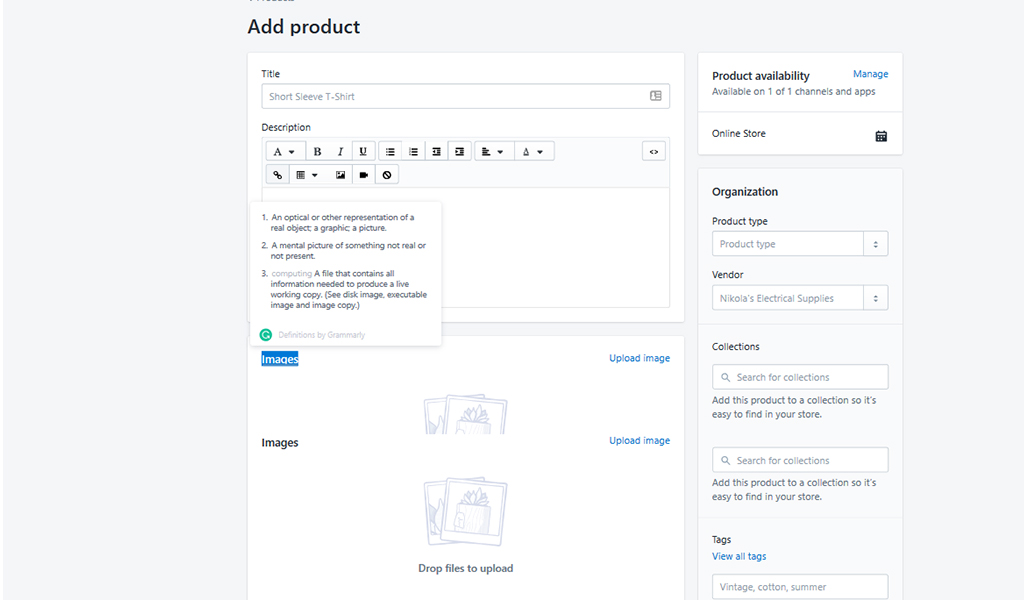
7. Other settings
Other items under your Settings let you customize your checkout process, view your invoices, manage how you ship orders to customers, charge taxes and much more.
When you’re done setting up, click the Launch website button and your store will be live. That’s all there is to it – your Shopify store is open!
Wrapping up
You’ve set up your first Shopify store and learned how to add products, chosen a theme, added blog posts and pages, bought your domain and chosen a payment processor. Next, soak up all the knowledge you can about how to keep it profitable and avoid making mistakes. Website Builder Expert also has an updated Shopify Review for 2019 that explores pros and cons, ease of use and more.
If you have any questions, Shopify has a great Help Center and Introduction guide. Looking for tips on email marketing, product photography, shipping and fulfillment and more? Visit shopify.ca/guides.
